Signals
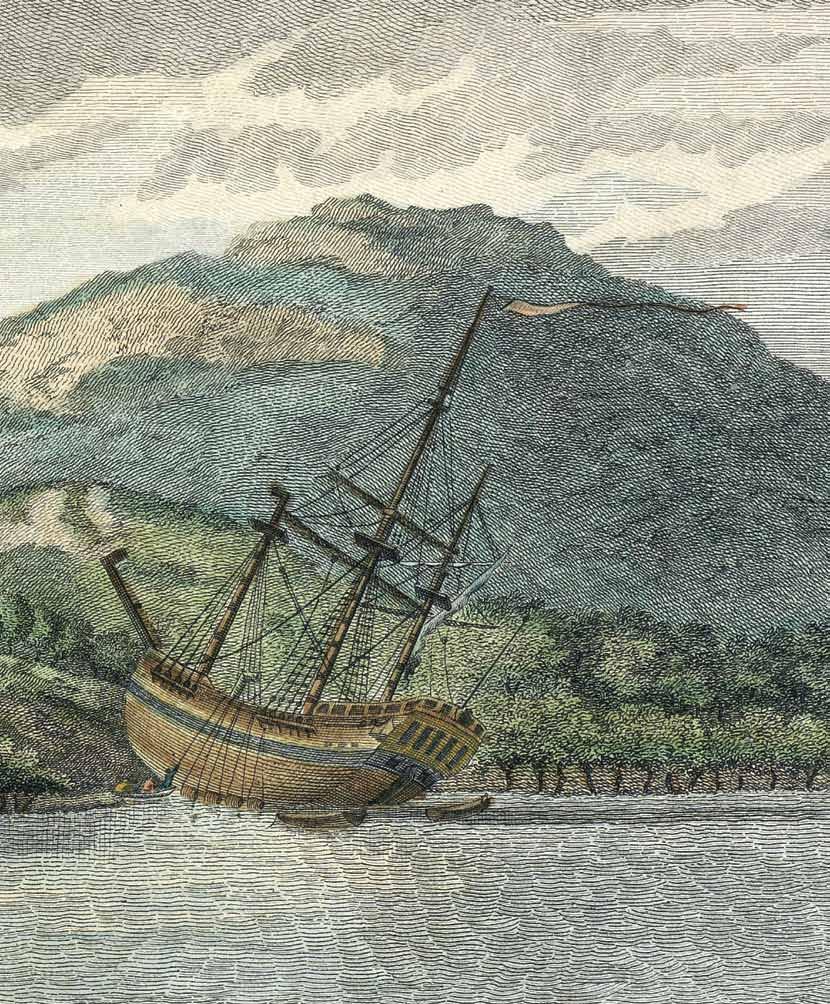
September October November 2011 Number 96

From April 2011 to May 2012 the magnificent replica of James Cook’s HM Bark Endeavour is visiting major and regional ports around Australia. Experience the life lived by Australia’s early European explorers.
Limited voyage crew and supernumerary berths are still available on some legs – numbers are strictly limited – book your place now!
Bookings & information
Telephone 02 9298 3859 Freecall 1800 720 577 www.endeavourvoyages.com.au



with us as HMB Endeavour makes its first-ever circumnavigation of Australia.
Sail
AUSTRALIA
Broome Darwin Cairns Townsville
Gladstone
Brisbane
Melbourne
Sydney Hobart
Adelaide
Geraldton
Thursday Island
Exmouth
Fremantle Bunbury
Albany Port Lincoln Portland Eden
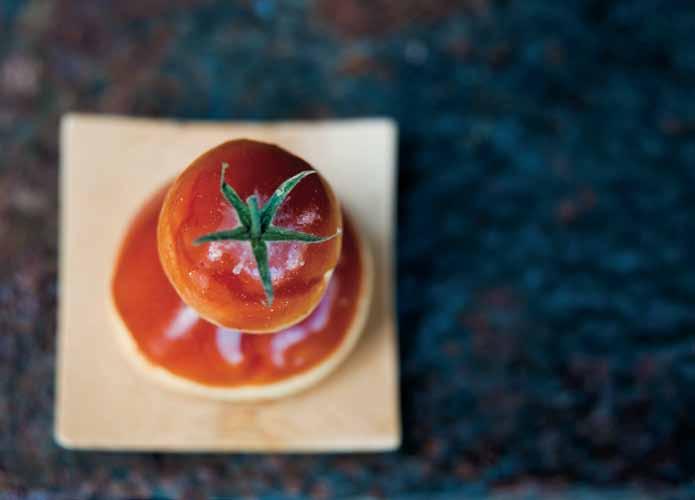
After renovations, Yots and the Ben Lexcen Terrace are open again for venue bookings – revitalised on the inside with the same fantastic views outside.
For formal dinners, stylish cocktail parties and memorable product launches, your guests will be delighted by our magnificent waterfront venues overlooking the historic fleet.
Award-winning Laissez-faire Catering offers flexible and exclusive menus. Book now for Christmas by the water.
T: +61 2 9298 3625 venues@anmm.gov.au www.anmm.gov.au/venues

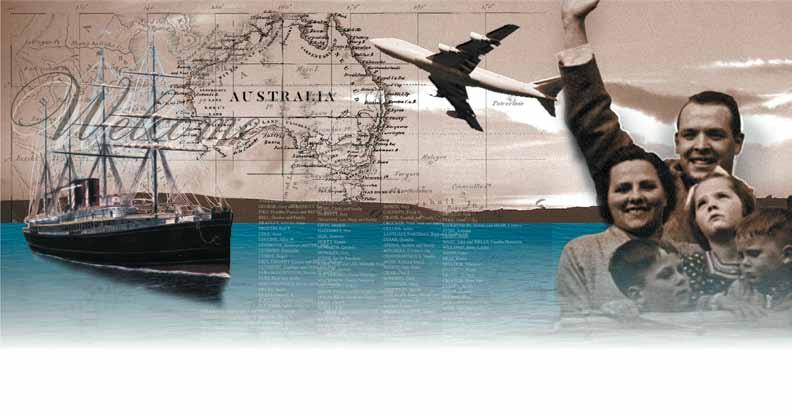
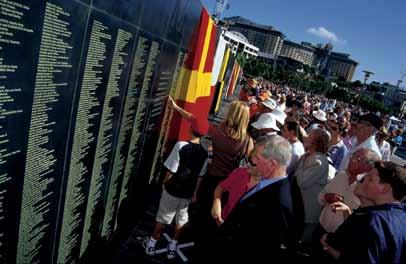
More than six million people have crossed the world to settle in Australia. Was your family among them?
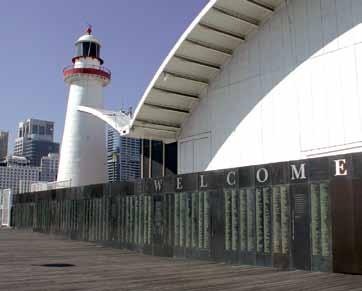

To honour our unique heritage, the National Maritime Museum has created the Welcome Wall to record your name in bronze and your stories for future generations. The Welcome Wall honours our immigrants, however they travelled, wherever they landed and wherever they live today.
An ideal tribute to loved ones that will last forever.
Call 02 9298 3777 or visit www.anmm.gov.au/ww to register your name today.
NMM943_SIG2 new venue new
menu
Sig N al S 96 September t O N O vember 2011 1
bearings from the director, mary-louise
Williams
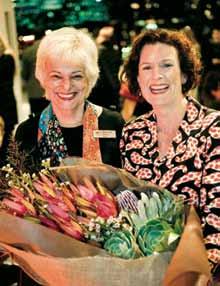
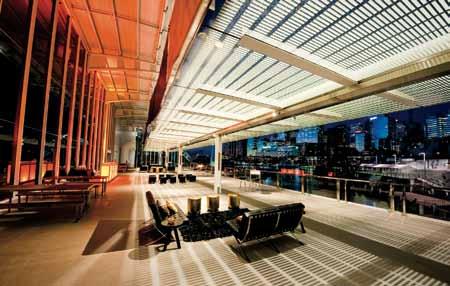
On 29 November it’s 20 years since the museum was opened to the public by then-Prime Minister Bob Hawke, and we are inviting all our readers and friends to celebrate with us. There will be a lively program of events, set out on pages 24–25 of this issue of Signals There’s certainly a lot to celebrate. We’ve seen the emergence of a vibrant, communicative and active museum on one of Australia’s most fabulous sites. The museum has staged an extraordinary variety of exhibitions and programs, involving people and groups well outside the norm for maritime museums as we developed relations with communities and organisations across Australia and all over the world. Our next issue of Signals, coming out at the time of the 20th anniversary, will share some of those memories – and yours as well.
With this major milestone approaching it’s time for me to announce a milestone of my own. I am retiring soon, and the recruitment process for a new director to lead the Australian National Maritime Museum into its third decade has begun as we go to press. It’s more than 23 years since I first joined the museum as its senior curator, in May 1988, and at the time of its opening I was assistant director (Programs Branch). After heading the Collections and Exhibitions Branch for
some years I became director in 2000. My time here has been immensely satisfying and enjoyable, but there always comes a time to move on. With our 20th anniversary celebrations and programs approaching I look forward to lots of opportunities to say farewell in person to those many friends and colleagues who have made working here so rewarding.
Sadly I have to mark the passing of one of those old friends of the museum – Horrie Young, who sailed as leading telegraphist on the commando raider Krait during one of the greatest feats of Australian arms of World War II. That was Operation Jaywick in September 1943 when thousands of tons of enemy shipping were sunk during this stealthy commando raid on Singapore Harbour. Horrie, who died in July aged 90, was the last survivor of that band of heroes. We have known him for 20 years, the period that Krait has been in the care of the museum. This gentle and dignified veteran returned to the museum every year for the annual Remembrance Day service that we hold in the presence of Krait, which is considered to be a floating war memorial. Last year he shared his memories with 50 high school students who attended the service. He will be warmly and well remembered.
Director mary-louise Williams and food writer and tv personality Joanna Saville at a cocktail function in July to introduce our glamorous new harbourside venues, the Waterside Studio and ben lexcen Walk (pictured above right), to corporate clients. it’s part of the recently completed Stage 1 of the museum’s eastern Works project, including a redeveloped Yots Café that resumes full restaurant service in November. rasha photography
Welcome to two new members of the museum’s governing council, whose appointment for three-year terms was recently announced. They are Mr John Coombes and Ms Eva Skira. John served as the Maritime Union of Australia’s National Secretary from 1993 to 2000. In telling the story of Australia’s working waterfront the museum has enjoyed strong support from the MUA, including the donation of the Wharfies Mural from its former headquarters. John was one of the architects of the amalgamation of the former Seamen’s Union of Australia and the Waterside Workers’ Federation, to create the MUA. Eva Skira is currently Deputy Chancellor of Murdoch University and was Western Australian Chairman of the Securities Institute of Australia 2003–06. She will be a valued adviser drawing on extensive experience on the boards of a range of Australian industries, including construction, engineering, finance, infrastructure, education and health.
Sig N al S 96 September t O N O vember 2011 2
Cover: the Endeavour replica’s voyage up the Queensland coast this year, on the early legs of its 2011–12 circumnavigation of australia, retraced lieutenant James Cook’s 1770 sea tracks – and reminded us of his travails, including the ship’s grounding and holing on a coral reef. Hm bark Endeavour is shown being careened for repairs at endeavour river near today’s Cooktown in this detail from an engraving in the museum’s collection. Vue de la Rivière d’Endeavour sur la côte de la Nouvelle Hollande ou le vaisseau mis a la bande (view of endeavour river … the bark laid on the shore). Hand-coloured engraving after a drawing by Sydney parkinson, published paris, France 1774. aNmm collection
Signals magazine is printed in australia on impress Satin 250 gsm (Cover) and 128 gsm (text) using vegetable-based inks on paper produced from environmentally responsible, socially beneficial and economically viable forestry sources.
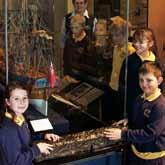
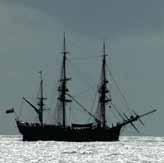



2 bearings
From the director
4 Connected by coral
Joseph banks, ballast iron, lighthouses and lightships, robert louis Stevenson and many other links
12 Endeavour circumnavigation 2011–12 across the tropics, meteorology and oceanography, indigenous voyagers
18 Historic raN ships in australia as the raN celebrates its centenary we look at raN historic ships preserved around australia
22 Tampa and Siev X – ten years on immigration policy, asylum seekers, unauthorised boat arrivals – all still contested a decade later
24 museum celebrates 20 years twenty years since the museum opened its doors to the public, plenty of celebrations
27 members message and events
From the members manager, the spring calendar of talks, tours, cruises, seminars, activities afloat
32 What’s on this spring exhibitions and activities for visitors young and old, including school-term and vacation programs
38 greenwich National maritime museum update big new developments at this leading maritime museum, headed for the first time by an australian
44 australian register of Historic vessels
New additions to this important national database
48 tales from the Welcome Wall bathsheba ghost – a convict woman’s rise from adversity
50 Collections around the world with Janet Stevenson
54 Currents Submarine man; mb 172; new club for modelmakers; call for papers
59 Sponsors tracking a turtle from taronga
September to November 2011 Number 96 Contents 4 24 12 Cert no SGS-COC-006189
Signals
38
18 Sig N al S 96 September t O N O vember 2011 3
Connected by coral Six degrees of separation in maritime history
the museum’s teacher-guides enrich student visitors’ experience with their wideranging knowledge of the twists and turns of history, stories that can flesh out the various curriculum points. teacher-guide Wendy Dyson follows a fascinating thread that connects Joseph banks, robert louis Stevenson, a two-century-old lighthouse and the ballast from James Cook’s Endeavour.
10 July 1770
‘... Went to bed in perfect security, but scarce were we warm in our beds but we were called up with the alarming news of the ship being fast ashore upon a rock, which she in a few moments convinced us of by beating very violently against the rocks. Our situation became now greatly alarming… ’
This dramatic description of the neardisastrous holing of Lieutenant James Cook’s HMB Endeavour on the Great Barrier Reef is from Joseph Banks’s Journal of a voyage to New South Wales Banks had been recommended to the British Admiralty for Cook’s great Pacific voyage of discovery by the learned fellows of The Royal Society of London for Improving Natural Knowledge, as a ‘gentleman of large fortune who is well versed in natural history’. Banks paid handsomely to join Cook’s voyage accompanied by his own entourage of scientists, servants and dogs. Pursuing what Banks called ‘the advancement of useful knowledge’, their ‘botanising’ and collecting had by July 1770 amassed a wealth of plant and animal specimens from both land and sea.
Cook had noted submerged reefs as he sailed north up the coast of what is now Queensland, but had not guessed their extent. The ship’s lucky escape was recounted by Dr Nigel Erskine in ‘Revisiting Endeavour’s scrap yard’ in Signals No 88, September 2009. Two more days of pumping and the stratagem of ‘fothering’ – smothering the hole with a sail stretched over the hull – enabled Cook to careen the hull at what is now the Endeavour River. Luck played a part too: a piece of coral had lodged in the hole, slowing the ingress of water. Famously it was while temporarily marooned here that Europeans first killed, drew and ate the creature that Banks transcribed in his collection of Indigenous vocabulary as ‘kangooroo’.
Year
Dawn the next day found the ship still stuck fast despite desperate pumping and the dumping overboard of cannon and ballast of iron and stone. Now Banks wrote: ‘In my own opinion, I intirely gave up the ship and packing up what I might save, prepard myself for the worst.’
Meticulous and responsible even in emergency, Cook inscribed his chart with an X where he had jettisoned the Admiralty’s property and some of it was later recovered in 1969. Three of the cannon remain in Australia, one in Canberra and the others near two of Cook’s landing sites: at Kurnell, NSW, and at Cooktown, Queensland. In the Australian National Maritime Museum’s own Navigators exhibition, visitors encounter another piece of this history. It’s an unassuming iron bar, rough-cast and eroded by two centuries’ immersion, smoothed by protective layers of wax. It’s a piece of the jettisoned ballast from Endeavour, displayed next to a magnificent model of Cook’s ship.
Sig N al S 96 September t O N O vember 2011 4
4 children from St mary’s primary School, rydalmere, learning more about James Cook and Endeavour from aNmm teacher-guide Zena Cohen. encountering a piece of Endeavour ballast in front are emma gallagher and Jake Donaldson, both 9. photographer a Frolows/aNmm
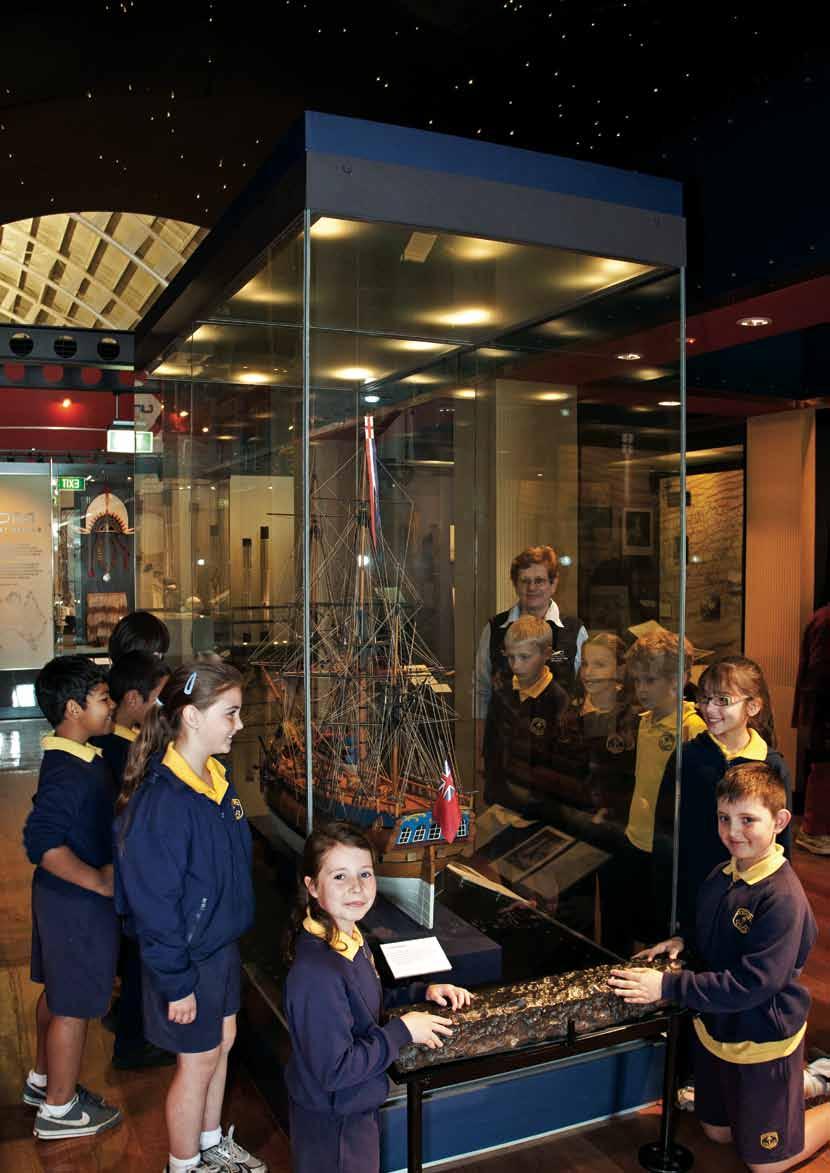
This unassuming iron bar, rough-cast and eroded by two centuries’ immersion, is smoothed by protective layers of varnish
Sig N al S 96 September t O N O vember 2011 5
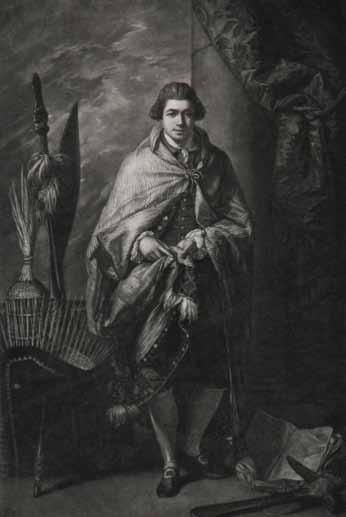
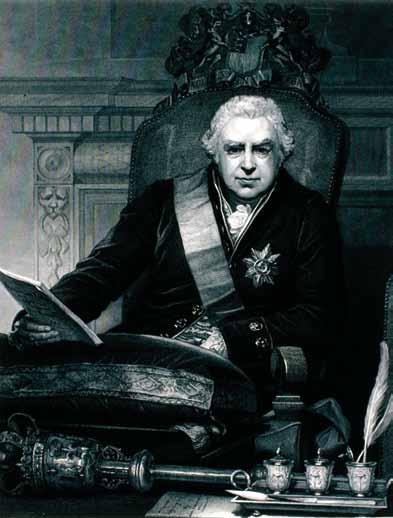
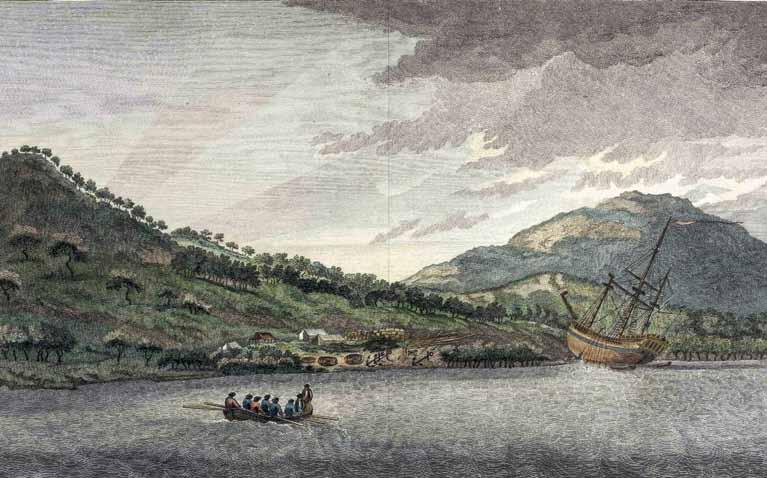
Sig N al S 96 September t O N O vember 2011 6
Some writers have referred to Sir Joseph Banks as the ‘father of Australia’
opposite: two of a series of formal portraits of banks in the aNmm Collection that show his transition from exuberant youthful explorer to long-standing president of the royal Society.
top left: banks wears a maori flax cape; around him are a basketwork helmet, club, canoe paddle, adze and an album of botanical specimens open at banksia. mezzotint engraved by J r Smith after a painting by benjamin West, published london 1788. aNmm Collection
top right: the right Honourable Sir Joseph banks, president of the royal Society, wears the Order of bath star. Copper engraving by N Schiavonetti after a painting by thomas phillips, published london 1812. aNmm Collection
left: Endeavour being repaired after grounding on the great barrier reef. Vue de la Rivière d’Endeavour sur la côte de la Nouvelle Hollande ou le vaisseau mis a la bande (view of endeavour river … the bark laid on the shore). Hand coloured engraving after a drawing by Sydney parkinson, published paris, France 1774. aNmm collection
above right: views of the inchcape or bell light, under construction and in operation, from The Story of our Lighthouses and Lightships Descriptive and Historical by W H Davenport adams, thomas Nelson and Sons 1891.
aNmm vaughan evans library
Primary and secondary school students are especially intrigued by this silent link to the voyage that had such momentous consequences for the continent they inhabit. We, the museum’s professional teacher-guides, invite our young visitors and their teachers to touch the cool, smooth iron during our tours and workshops.
The programs that we conduct for students range from the chemistry of marine corrosion to migration stories, from walks exploring Pyrmont’s dockside history to piratical treasure hunts on the mighty iron barque James Craig They’re among the myriad tales hidden in the deep waters of Australia’s maritime history and culture. Inevitably, tight schedules mean that many stories must await further study, back at school or on a return weekend visit with the family. One such hidden tale – of the ‘six degrees of separation’ kind – curiously connects the Endeavour ballast, the famed Scots author Robert Louis Stevenson, the museum’s lightship Carpentaria, relics collected on Cook’s second voyage that were recently acquired by the museum … and even the foundation of the museum itself.
The link is Joseph Banks’s close call with coral.
Returning to England with Cook in 1771, Banks’s collection of South Seas shells, plants, seeds, animal skins, dried fish, geological specimens, seaweed and insects, and Sydney Parkinson’s beautiful sketches and paintings, caused a sensation when displayed in Banks’s London residence. He and the sole surviving scientist from his Endeavour entourage, Carl Solander, were introduced to King George III, and Banks’s lifelong career as a trusted advisor and patron of Britain’s antipodean activities began. In 1779, the year of Cook’s death in Hawaii, Banks was one who strenuously advocated Botany Bay as the new destination for British convicts whom the newly independent American states now refused to accept. Some writers have referred to Sir Joseph Banks as the ‘father of Australia’. He advised Governors from Phillip (recommending what plants and seeds he should take with the First Fleet) to Macquarie; sponsored Matthew Flinders’ 1801–03 circumnavigation of the continent; championed Bligh as Governor of New South Wales; and carried on a vast correspondence on matters of importance connected with the colony.
The energetic and influential Joseph Banks had interests in numerous other areas. One example takes us on a voyage


to the east coast of Scotland, and a great rock shelf lying offshore on the approach to Dundee called the Inchcape Rock (sometimes known as the Bell Rock). Nearly half a kilometre long and submerged or awash in all but spring tides, it had been known and feared as a ship-killer since mediaeval times. Robert Southey’s ballad of 1820, The Inchcape Rock, relates the legend of an abbot of Arbroath who rows out to place a warning bell on the sunken menace:
On a buoy in the storm it floated and swung
And over the waves its warning rung
When the rock was hid by the surge’s swell
The mariners heard the warning bell ...
Some readers may remember that the poem satisfyingly concludes with poetic justice for Ralph the Rover, a pirate who removes the bell to spite the abbot but then himself is wrecked and drowned when a fog obscures the swell:
Now where we are I cannot tell
But I wish we could hear the Inchcape Bell! It’s been said that in Banks’s day, as many as six ships a year were being wrecked on this hazard – and some were wrecked
Sig N al S 96 September t O N O vember 2011 7
trying to avoid it! Despite the obvious need for a lighthouse on the rock, Britain’s Northern Lighthouse Board had long regarded construction there impossible or, at the very least, too expensive. The engineer John Smeaton had built the famous Eddystone Lighthouse on a semisubmerged rock off England’s Plymouth Banks, but at the Inchcape Rock a tower’s footings would lie even deeper in the battering North Sea. Nevertheless, after studying Smeaton’s Eddystone light and visiting the Bell Rock, one of the board’s young employees, Robert Stevenson, began drafting plans for a mighty light on Inchcape. This Stevenson, apprenticed in his stepfather’s Edinburgh engineering firm, was the future grandfather of writer Robert Louis Stevenson.
After some modification by a more senior engineer, George Rennie, Stevenson’s design was submitted by the Northern Lighthouse Board to the Privy Council’s Board of Trade for funding approval. The cost was enormous and the Admiralty argued that the benefit would be too localised to justify the expense. However, at least one member of the Board of Trade knew ‘from personal experience the horrors of sunken rocks’ – as the meeting’s minutes tell us – and voted to supply the funds.
The member was Sir Joseph Banks, a Privy Councillor since being created a baronet in 1781. Banks had undertaken other scientific expeditions, to Labrador and Newfoundland (1766) and to Iceland (1772), and sailed parts of the British coast. He had lost specimens and had his cabin swamped during gales on the high seas, but his only experience of holing on submerged hazards was with Cook in 1770. It had left a vivid impression: his Endeavour journal speaks of ‘sunken coral rocks, the most dreadful of all others on account of their sharp points and grinding quality which cut through a ships bottom almost immediately’.
In July 1806 Royal Assent was received for the construction funding voted for by Banks. Stevenson was so grateful for this support that he named the purpose-built 84-ton schooner that served as a tender for the new lighthouse’s construction Sir Joseph Banks. Accommodating 40 artificers and 17 crew, with a cabin for Stevenson when he was aboard, the vessel was crucial to the project. The foundations could only be commenced at low tides, and wild weather often made work impossible. Finally, however, in 1811, the Bell Rock (or Inchcape) Lighthouse, 35 metres from base to top, sent out its ‘ruddy gem of changeful light’,
as Sir Walter Scott put it. With later improvements but with the original masonry intact, it is the world’s longeststanding sea-washed lighthouse, and it celebrates its bicentenary this year.
Memories of Endeavour Reef may not have been the only spur for Banks’s support of the Bell Rock project. Passionate about improving his extensive estates for pasturing and agriculture, Banks had previously consulted Smeaton and Rennie – the two engineers associated with Stevenson’s project – over the problem of ‘drowned lands’, or fens subject to tidal inundations. He had entertained them at his country mansion and so perhaps was predisposed to support their project. Earlier, in 1775, Banks had gone by boat to inspect Smeaton’s great Eddystone light himself.
On this excursion, it seems, Banks had with him none other than the Tahitian Omai, whose ‘relics’ are displayed at this museum near the Endeavour ballast. These Tongan and Maori artefacts never belonged to Omai, as Dr Stephen Gapps explains in Signals No 89 December 2009 (‘Omai relics from the Furneaux collection’). They were collected by Lieutenant Tobias Furneaux, master of the Adventure on Cook’s second circumnavigation, and arrived in Britain in 1774 on the same vessel as Omai. Banks had first met Omai in 1769 on Cook’s first circumnavigation, and became the Tahitian’s host and protector when at last he reached England. As well as introducing the celebrated Polynesian into society, Banks’s hospitality in 1775 included a cruise on the yacht Augusta – this was the occasion of the visit to the Eddystone light.
Back at the museum our young museum visitors, leaving the galleries and strolling by the Welcome Wall towards James Craig, cannot fail to notice the pillar-box red Commonwealth Light Ship 4 Carpentaria (CLS4 for short), moored near Wharf 7. Floating lightships marked dangers such as shoals or sandbanks or other hazards that were impossible to build on. Carpentaria once warned mariners of the Merkara shoals in the Gulf of Carpentaria. Together with its four sister ships it was built at Sydney’s Cockatoo Island Dockyard in 1916–17 to the designs of Scottish naval architects D & C Stevenson. These were grandsons of the Robert Stevenson whose success as the dedicated construction manager of the Bell Rock Lighthouse began an engineering dynasty specialising in lighthouses. One of Carpentaria’s sisters was anchored on Breaksea Spit north
Both Banks and RLS shared a fascination with the art of tattooing and described the process, patterns and their apparent social function
opposite top: the museum’s Commonwealth lightship 4, moored at Wharf 7 adjacent the museum, was designed by Scottish naval architects D & C Stevenson, cousins of robert louis Stevenson, all members of the Stevenson dynasty of lighthouse and lightship engineers. rlS dropped engineering for a life of literature. photographer J mellefont/aNmm opposite bottom: robert louis Stevenson (seated centre back row), flanked by his mother-in-law, stepson and wife Fanny, at his home vailima in Samoa in 1892. photographer unknown
Sig N al S 96 September t O N O vember 2011 8
of Fraser Island’s Sandy Cape, both named by Cook on 20–21 May 1770. Cook also named Cape Bowling Green near Townsville, where the museum’s lovely prefabricated lighthouse was first erected to guide ships traversing the inner passage of the Great Barrier Reef.
Alert visitors notice that CLS4 Carpentaria has a bell mounted in a framework cage on deck. It sonorously responds to swells as minor as the wake from an inner-harbour ferry leaving the Pyrmont Bay wharf. Some marker buoys in Sydney Harbour also have bells, ringing to alert mariners – the Junction Bell or North Channel Marker, visible from the Manly ferry, is one. They remind us how waves over the Inchcape Rock may have set a mediaeval abbot’s bell ringing in Scottish seas all those centuries ago.
Robert Louis Stevenson was a cousin of Carpentaria’s designers. His father had apprenticed him in the family business but, luckily for literature-lovers, neither the mathematics nor the cold conditions of lighthouse inspections suited RLS.
Enjoying success as a travel writer and novelist, the year 1888 found RLS – like Banks in the previous century, sailing in the South Seas – although on a voyage of discovery of a quite different kind, and with his family. He had visited Sydney twice (related in ‘Stevenson’s Hurricane’ in Signals No 32 November 1995) before settling in Samoa. Fanny, his wife, claimed kinship with Cook himself through a cousin; consequently the Samoans sometimes called her ‘tappitan Tootoo’ – Captain Cook! RLS fancifully links the great navigator with magical but infernal power in one of the most famous stories from his Island Nights’ Entertainments collection, ‘The Bottle Imp’: ‘Napoleon had this bottle and by it he grew to become king of the world; but he sold it at last, and fell. Captain Cook had this bottle and by it he found his way to so many islands; but he, too, sold it and was slain upon Hawaii’, says one of the bottle’s haunted owners.
Like Banks, RLS took great interest in the dress and culture of the Polynesians he was interacting with, but his writings reveal more respect and sympathy for these alternatives to European ways and beliefs. Banks collected ethnographic curiosities – a Maori feather cape for instance. RLS collected stories and Samoan friends. Both men shared a fascination with the art of tattooing and described the process, patterns and their apparent social function. Banks’s and Cook’s journals are the first to record the


Sig N al S 96 September t O N O vember 2011 9
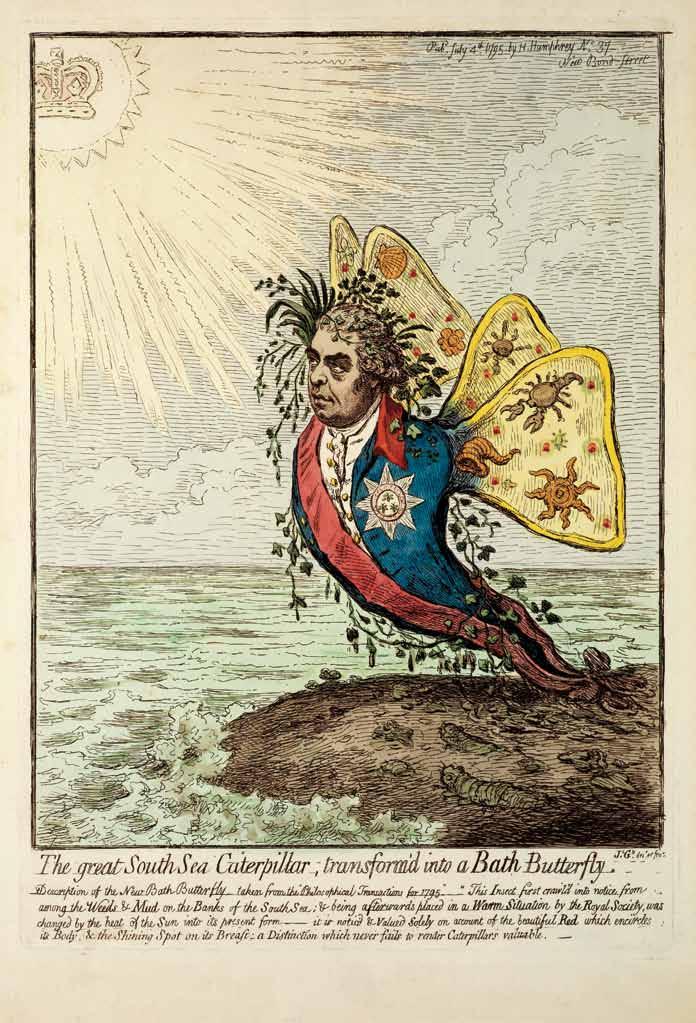
Sig N al S 96 September t O N O vember 2011 10
In literary terms Banks was no Robert Louis Stevenson, but his wit and intellect bring Cook’s Endeavour voyage vividly to life
Tahitian word ‘tattau’, which became ‘tattoo’ in English. There is some evidence that Banks had his arm discreetly tattooed. RLS didn’t get a tattoo of his own but the fugitive pirate ‘Billy Bones’ in the author’s Treasure Island has some fearsome tattoos – including a gallows and hanged man!
As President of the Royal Society from 1778, a supporter of Kew Gardens and an ex-officio trustee of the British Museum, though, Sir Joseph Banks ensured that Australian geology, flora and fauna were preserved, studied and incorporated into contemporary Europe’s scientific understanding of the planet. His London Soho house became both a library and museum for scientific colleagues and Banks would fund naturalist collectors to seek out specimens, in China and Africa as well as Australasia. Banks was passionate about ‘useful’ plants, in keeping with his British agricultural interests. He ensured that the ships carrying his collectors had adequate ‘plant cabbins’ and the techniques that he and his collectors developed to preserve seeds enabled a flow of plants to and from Sydney in the new colony.
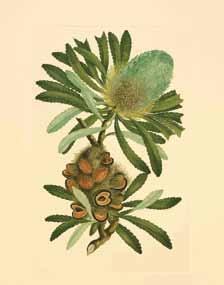
Caricature of the newly knighted Sir Joseph banks transforming from a caterpillar into a butterfly as he rises from a mud bank in the South Seas, wearing the Order of bath star and bathed in the radiance of the sun, his monarch george iii the inscription lampoons the mode of scientific description that banks, a disciple of linnaeus, had done so much to promote. etching by James gillray, published 4 July 1795 by H Humphrey No. 37 New bond Street, london. aNmm Collection
this engraving, based on Endeavour artist Sydney parkinson’s watercolour of the specimen famously named after Joseph banks, toured australia in our travelling exhibition Joseph Banks and the flora of the Australian east coast it’s from Banks’ Florilegium plate 285 Banksia serrata, aNmm Collection, gift from Dr eric and mrs margaret Schiller. © Natural History museum, london
Although active in so many spheres Banks published little in his lifetime. Banks’s Florilegium, engravings of beautiful botanical illustrations done in Endeavour’s Great Cabin by Sydney Parkinson, was finally published in 1990 by Alecto Historical Editions and the Natural History Museum, London. The Australian National Maritime Museum has toured selected copies of plates from our own precious copy in the exhibition Joseph Banks and the flora of the Australian East coast, described by Lindsey Shaw in Signals No 87, June 2009. They remind us of Banks’s influence on Sydney’s Royal Botanic Gardens, the oldest scientific research organisation in the southern hemisphere. Banks, an instigator of the British Linnaean Society, was the patron and original employer of the second colonial botanist Alan Cunningham, who became Superintendent of Sydney’s Botanic Gardens.
Curator Paul Brunton from the State Library of NSW, custodian of Banks’s Journal, has argued that it is ‘the single most important document relating to Australia’. Cook occasionally borrowed from it and adopted something of Banks’s style in his own log. Banks lent his journal to Matthew Flinders as a reference work; it miraculously survived shipwreck and passed through several private hands before becoming part of David Scott
Mitchell’s bequest to the nation. It was published in full for the first time in 1962 by the library and Angus & Robertson. Despite his extensive patronage and enormous contribution to scientific activity in many fields, Banks’s reputation is mixed. Physically and in terms of wealth, status and influence he was a large character, and inevitably attracted resentment and lampoons – the museum has a copy of the famous contemporary cartoon of Banks as a ‘South Seas caterpillar’. Nonetheless one can argue that his passion for collecting and his deep interest in the exotic – both for its novelty and its possible usefulness to society – led, through his activities and philosophical legacy, to the foundation of institutions such as the Royal Botanic Gardens and the Australian Museum. And these in turn led the way to the foundation of the Australian National Maritime Museum itself.
In literary terms Banks was no Robert Louis Stevenson, but his wit and intellect bring Cook’s Endeavour voyage vividly to life – writing, for example, of the feverish pumping of the ship (in which this adventurous peer took equal part) when it appeared to be sinking in July 1770:
‘Orders were now given for lightning the ship which was began by starting our water and pumping it up; the ballast was then got up and thrown over board, as well as 6 of our guns (all that we had upon deck). All this time the Seamen workd with surprizing chear-fullness and alacrity; no grumbling or growling was to be heard throughout the ship, no not even an oath (tho the ship in general was as well furnishd with them as most in his majesties service).’
Sig N al S 96 September t O N O vember 2011 11
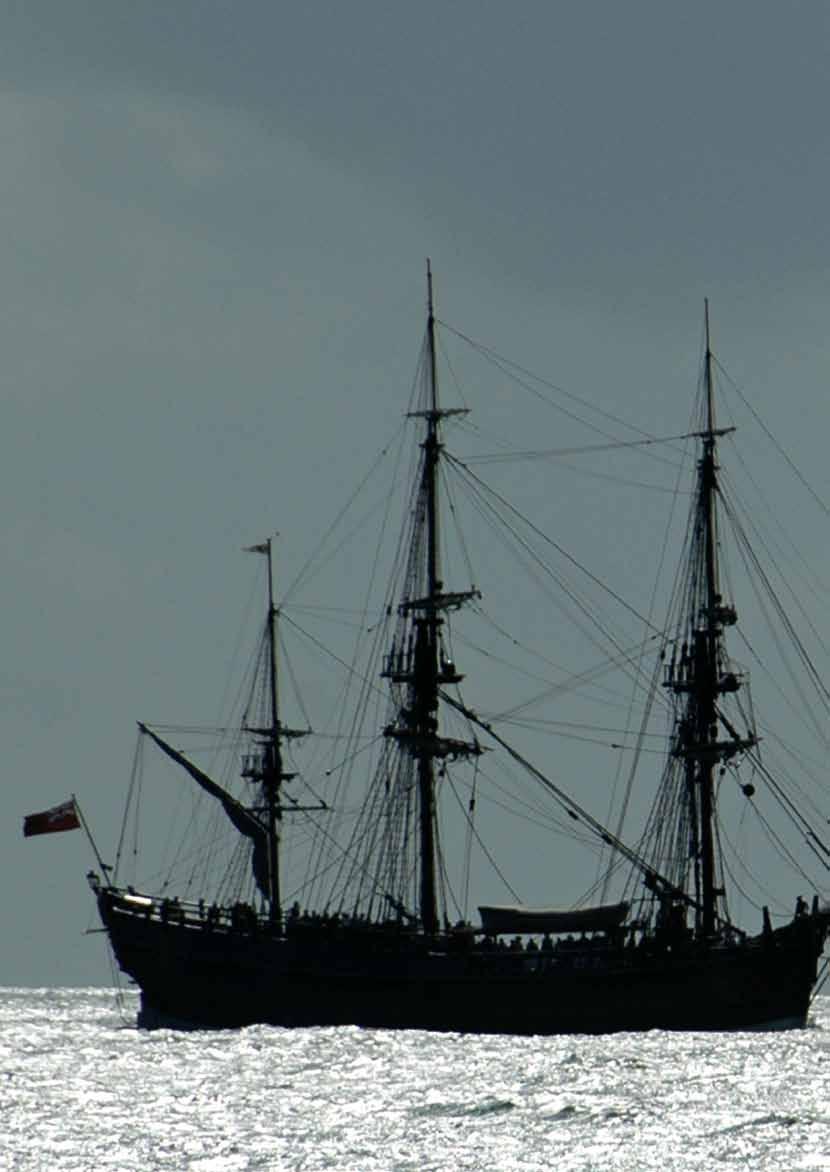
Hmb Endeavour in the tropics
Sig N al S 96 September t O N O vember 2011 12
as Signals goes to press the replica of Hm bark Endeavour has reached Darwin via torres Strait during its 2011–12 circumnavigation of australia. in this issue, however, we focus on the winter voyage up the coast of Queensland in the wake of James Cook. Curator Dr Stephen Gapps visited Cooktown, site of Cook’s longest stay on australian soil after his fateful encounter with the great barrier reef.
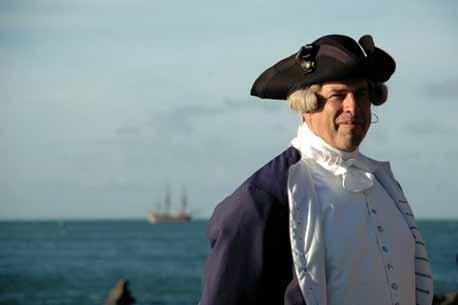
It was in the land of the Guugu Yimitthir people, at Endeavour River near today’s Cooktown, that Lieutenant James Cook and his crew spent the longest period of time ashore of all the 13 landfalls that they made along the eastern coastline of our continent in 1770. It was here in July of 1770 that they repaired their damaged vessel, holed on a moonlit night on a coral reef. Here too the scientists and crew of Endeavour collected many plants and animals, finally killed a specimen of the elusive kangaroo, and spent a good deal of time attempting to communicate with the local Aboriginal people.
Indeed, the residents of Cooktown today note that their locality was the site of the first instance of reconciliation between Europeans and Indigenous Australians. Cook’s efforts to communicate had turned sour after the local people found that the Endeavour crew would not share the catch of turtles they had taken in the country of the Guugu Yimitthir. But after the crew members returned some spears they had picked up, this ‘reconciled everything’ in the words of Cook’s journal. The Endeavour’s 1770 stay was in some ways a rehearsal for future relations between Europeans and the First Australians,
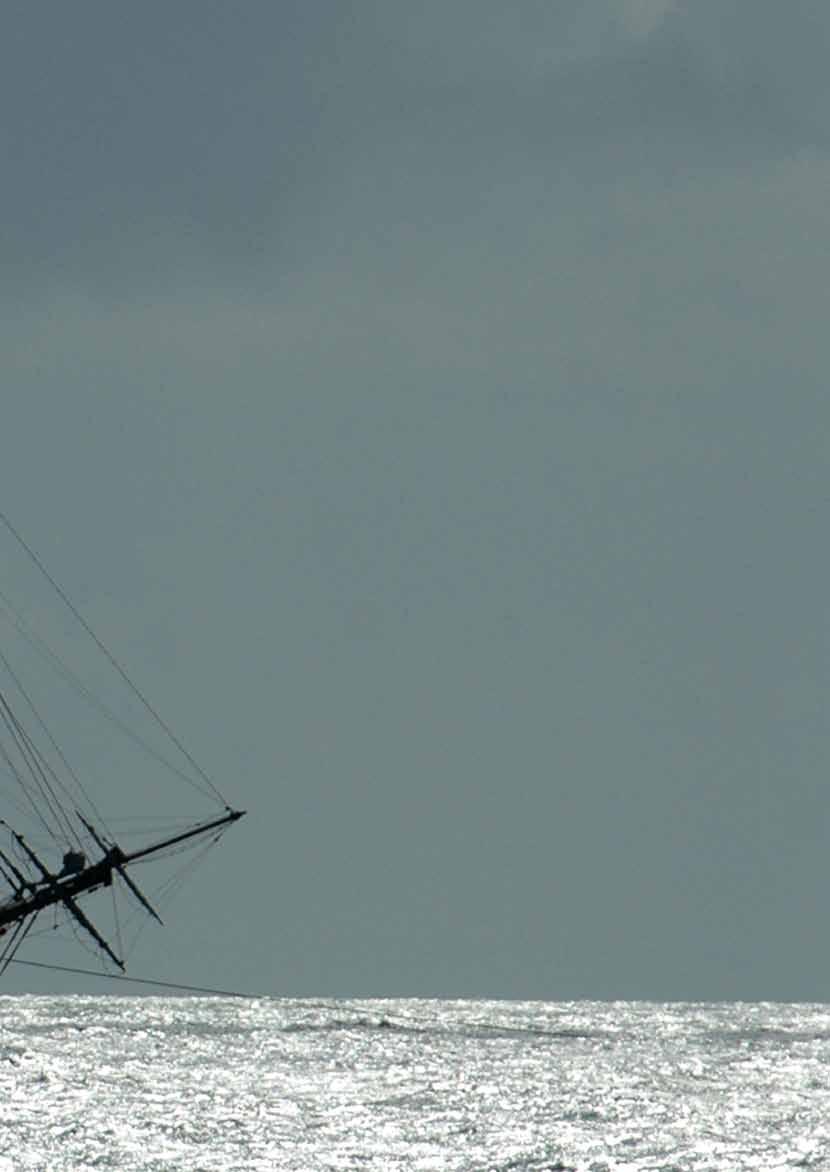
with many familiar elements appearing: cultural misunderstanding, conflict over resources, enquiry, negotiation.
In July 1770 James Cook climbed the hill at the southern head of Endeavour River several times to try to spy a way through the treacherous reefs that seemed to stretch forever up the coastline. On a windy July afternoon in 2011, scores of Cooktown residents and tourists drove their cars up to the vantage point of Grassy Hill to view the Endeavour replica sailing in to Cooktown after its voyage from Cairns.
The view of Endeavour blustering along with some sail up, and then anchoring at the mouth of the river, was spectacular. It conjured up images of what it was that the Guugu Yimitthir saw on their ocean in July of 1770. Unfortunately the vessel could not risk mooring in the river where the clearance was reportedly in the range of centimetres rather than metres. Endeavour’s Captain Ross Mattson had hoped to come ashore and attend a series of engagements that the Cooktown Council and Cooktown Re-enactment Association had coordinated. A modern-day Captain Cook and his marines, members of the re-enactment association, waited on shore to welcome him.
Sig N al S 96 September t O N O vember 2011 13
The original Endeavour voyage was very much about scientific enquiry.
Fittingly then, the Endeavour
replica has also become involved in scientific data collection
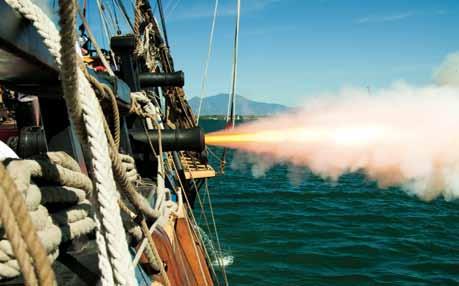
Unfortunately the winds picked up, gales were predicted and the vessel’s anchor dragged in the sandy mooring overnight, so Captain Mattson made the difficult decision not to stay for the scheduled two days, but to head back out to sea. Although this was a great disappointment for the people of Cooktown, it was prudent not to risk the Endeavour replica amid the same sharp coral traps that came so close to destroying the original vessel 241 years ago.
The original Endeavour voyage was very much about scientific enquiry. Fittingly then, the Endeavour replica has also become involved in scientific data collection. The ship has joined the Bureau of Meteorology’s Volunteer Observation Fleet, collecting and communicating meteorological observation data to the database of the Bureau of Meteorology while at sea. The first test observations were sent on 13 April 2011 and Endeavour’s officers have since submitted in excess of 100 observations to the Bureau.
The circumnavigation has also provided an opportunity for Endeavour to deploy surface drifting buoys to measure currents in two areas that are less frequented by shipping – the Hiri Current in the Coral Sea and the Leeuwin Current in the Indian Ocean. The buoys are tethered to a sub-surface drogue and drift with the oceans’ currents. They include instrumentation to measure ocean temperature and atmospheric surface pressure, and transmit these measurements and their position every three hours via satellite.
They are part of a drifting buoy program of over 1,500 buoys distributed around the globe under the administration of the National Oceanic and Atmospheric
Administration (NOAA), with the Australian Government’s Bureau of Meteorology making buoy deployments in the Indian and Southern Ocean. The data gathered provides information for weather prediction, and feeds into broader historical information about climate.
Endeavour deployed two buoys in the Coral Sea. On 11 July the ship left the shelter of the Great Barrier Reef for open sea and between 13 and 14 degrees south latitude the buoys were launched overboard by voyage crew Frank Mills and Jay Kaumees. The Hiri Current will carry them into the Gulf of Papua Gyre. At Frank’s suggestion they were named Manu 1 and Manu 2 – ‘bird of the sea’ in the Motu language of the Hiri people of coastal Papua New Guinea. The ship will deploy a further two buoys in the Indian Ocean on the Exmouth to Geraldton leg of the circumnavigation.
Cooktown has an intriguing history outside of the Endeavour associations. It was founded as a gateway to the Palmer River goldfields and its James Cook Museum has an excellent display of regional history. It is also the home of several of the artefacts that were jettisoned by Cook at Endeavour Reef to lighten the stricken vessel, including one of the Endeavour cannon and an anchor that were recovered in 1969. Cooktown’s Botanical gardens have living examples of all the species collected by Joseph Banks from the Endeavour River region in 1770, including the emblematic Cooktown Orchid.
Cooktown’s re-enactment association has been recreating elements of Endeavour’s 1770 stay for over 50 years. Recently, the Guugu Yimitthir people
have become more involved in the historical re-enactments and the annual Cooktown Discovery Festival, held each year over the June long weekend.
In November 2011 Cooktown is hosting a conference, ‘Towards 2020 – The 250th anniversary of the landing of Captain Cook on the east coast of Australia’, in a newly built conference centre facility. With a bit of good luck, the Endeavour River mouth will have been dredged by the time of the 250th anniversary and Cooktown might be able to welcome the vessel at close hand this time around.
For further information about the buoys launched from Endeavour and to monitor their progress of visit www.aoml.noaa.gov/phod/dac/index.php.
For further information on the Cooktown conference vsit www.cooktowndiscoveryfestival.com.au.
t hanks to Endeavour chief officer Dirk l orenzen; Dr gary brassington, bureau of meteorology; l oretta Sullivan, Cooktown re-enactment a ssociation.
above: Salutes from Hm bark Endeavour replica‘s four-pounders – themselves faithfully replicated by an armament factory in victoria – accompany the ship’s arrivals and departures. photographer Fiona Harper
previous page, inset: James Cook re-enactor rick ashcroft of the Cooktown re-enactment association. both photographs vanessa gillen
Sig N al S 96 September t O N O vember 2011 14






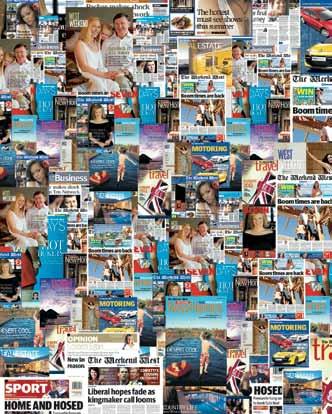


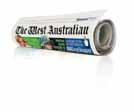
HMB Endeavour Around Australia 2011-2012 Voyage of a Lifetime PROUDLY SPONSORED BY C M Y CM MY CY CMY K history_endeavour_ad_FINAL.pdf 1 2/08/11 10:50 AM Sig N al S 96 September t O N O vember 2011 15
Hmb Endeavour voyage of reconciliation
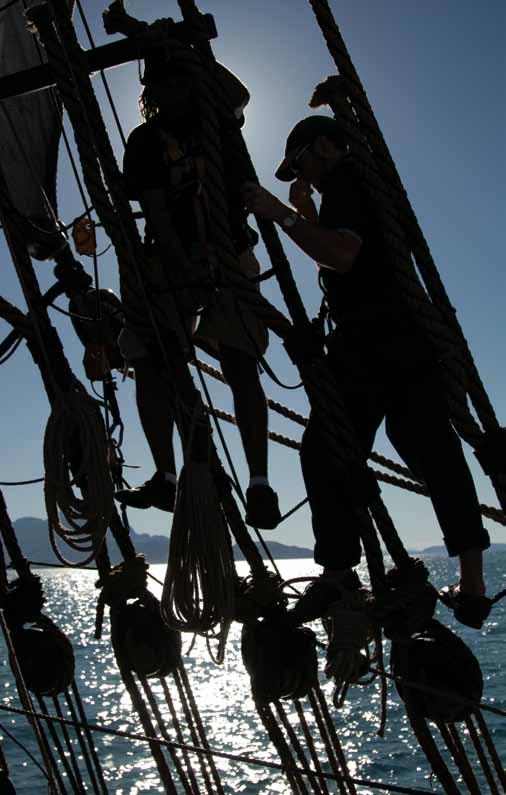
North Queensland marine journalist Fiona Harper sailed on the townsville to Cairns leg of the Endeavour replica’s australian circumnavigation in June. She recounts the camaraderie of tall-ship sailing that links professional and paying crew with the young indigenous people who have been given berths on each leg.
left: For new crew unused to square-rig sailing, the first trip aloft into the upper rigging is a rite de passage and a threshold. photographer Fiona Harper opposite: indigenous crewmembers alongside in Darwin when they disembarked after their voyage from thursday island. left to right: lionel Ogden, Shannon Cagney, mentor Dave Kurnoth of Workboats Northern australia, James Clarke, Carolas Dai and myti Wood. photographer belinda parry, DeeWr
Sig N al S 96 September t O N O vember 2011 16

‘The ship struck and stuck fast,’ notes James Cook as HM Bark Endeavour was holed on what’s now known as Endeavour Reef near Cooktown. Cook quickly displayed the leadership qualities for which the British Admiralty had appointed him, at the age of 38, to command the 1768–1771 voyage. Lightening the ship, staunching the leak and running her aground on the beach for repair was a remarkable feat of seamanship from the entire crew. Cook was proud of his officers and men, noting that no-one had panicked nor shirked their duty: ‘No men ever behaved better than they have on this occasion ... every man seemed to have a just sense of the danger and exerted himself to the utmost.’
This spirit of camaraderie, teamwork and seamanship lives on in the replica of his ship. One of the unique things about any sailing voyage is the bonds that emerge as the miles slowly slip astern. Following Cook’s original route northwards wherever possible (while naturally avoiding Endeavour Reef), there is ample opportunity to get to know fellow shipmates on the Endeavour replica. Coming from all walks of life, each has their own story to tell, gradually revealed as days revolve around watch keeping. After just a few nights of interrupted sleep performing oddly unfamiliar tasks in the dark, an intimacy soon develops that’s not seen among strangers ashore.
Embracing these bonds of friendship was particularly relevant to the Indigenous crewmembers on board, part of an initiative in the spirit of reconciliation that the ship’s custodian, the Australian National Maritime Museum, has willingly taken on. As the museum’s director Mary-Louise Williams
‘For me, this journey was a chance to walk in the footsteps of my ancestors who experienced the arrival of the First Fleet’
shipmates and they will look after you,’ is the message from the master to everyone from the officers all the way to the newest voyage crew. After just a few legs, results are becoming apparent, with one young Indigenous crewmember, Monique, saying that ‘being picked to crew on Endeavour was a once in a lifetime opportunity that changed my life’.
has said: ‘This voyage gives us the opportunity to build relationships and work with remote and regional communities and with Aboriginal and Torres Strait Islander people, to encourage mutual understanding of our shared history.’
The Job Futures Endeavour Project is an inspiring concept that will see up to 32 disadvantaged Indigenous jobseekers join the 33-metre sailing ship as voyage crew during her 2011–12 circumnavigation. It’s part of a partnership between the museum, the Federal Department of Education, Employment and Workplace Relations (DEEWR) and Job Futures, a not-for-profit network of communitybased employment agencies. It’s a partnership that is building relationships with Aboriginal and Torres Strait Island people enroute. The aim of the program is to assist disadvantaged Indigenous jobseekers to build skills and confidence in order to find meaningful employment. Some of these crew members are seeking work in the maritime industry, while others hope to use the experience to give them confidence to make positive change in their lives.
According to the master of the Endeavour replica, Captain Ross Mattson, many of these participants have found themselves way outside their comfort zone upon embarking. Though he too observes that tall-ship sailing does seem to bring out the best in people who are otherwise strangers.
‘To join a ship full of people of mostly European descent can be confronting. Fortunately we have sailing crew who by nature are very genuine people, who do not place people by gender or class,’ he says, which helps to ease the awkwardness of being confined in an unfamiliar environment. ‘Look after your
Another participant stepped ashore filled with enthusiasm for both his own future and that of his culture. ‘For me, this journey was a chance to walk in the footsteps of my ancestors who experienced the arrival of the First Fleet … to heal and move on to a better place where all Australians can know and understand each other better. It was a chance to share some of my culture with others,’ said Gary.
HM Bark Endeavour flies both the Aboriginal and Torres Strait Island flags alongside the Australian maritime ensign. ‘Arriving in port, people see the flags and make the connection about Cooks’ history. Could this ship be the perfect tool for reconciliation?’ wonders Captain Mattson, steely blue eyes scanning the horizon. ‘It’s very satisfying to watch these people grow in confidence as they, literally, learn the ropes. It’s a privilege to show them the essentials of 18thcentury seamanship and to remind them of Australia’s seafaring history,’ he says from beneath a dishevelled mop of curls prior to pointing Endeavour’s bow seawards again.
No pleasure cruise, each crewmember is expected to stand watch, climb aloft, wash dishes and keep the ship, well, shipshape. Once the sails are set and trimmed, conversation helps to while away the hours since the likely speed is a modest three or four knots. Sharing the experience, even the dirty jobs like hauling up by hand the tar-soaked, muddy, slimy anchor rope, seems to bring out the best in people. Perhaps it has something to do with the notice in the communal galley that urges crew to ‘Be excellent to each other’. Maybe it has more to do with lack of connection with ‘onshore’ lives as phone and internet connectivity drop out. Whatever the reason, getting to know one another is an unexpected treasure to take home from such a voyage.
Whether you call it reconciliation, friendship or simple humanity, as HM Bark Endeavour sails on, those lasting bonds that develop onboard are sure to remain long after she has returned to her home berth in Darling Harbour.
Sig N al S 96 September t O N O vember 2011 17
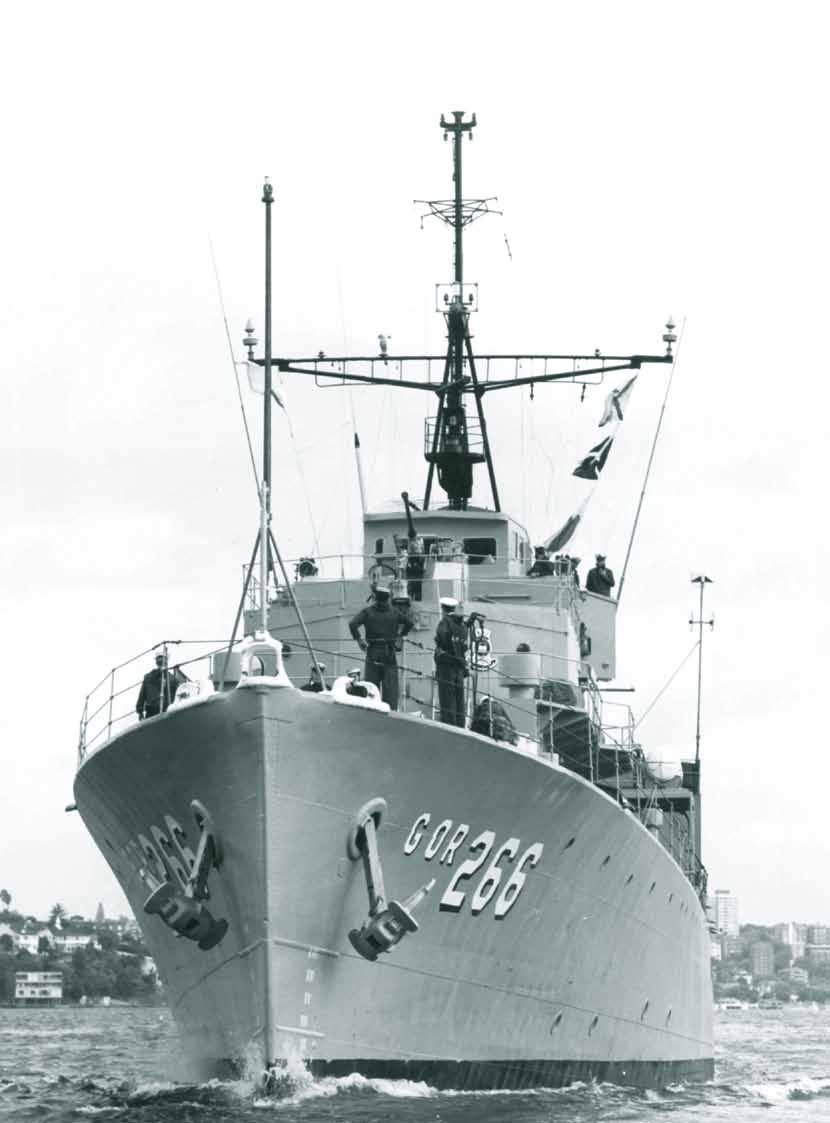
Historic raN ships in australia the first century
Sig N al S 96 September t O N O vember 2011 18
this year the museum has combined with the royal australian Navy to mark its centenary – 100 years since 10 July 1911 when King george v granted the title ‘royal’ to the 10-year-old Commonwealth Naval Forces, allowing its vessels to be known as ‘His majesty’s australian Ships’, says Lindsey Shaw, senior curator of maritime technology, exploration and naval history.
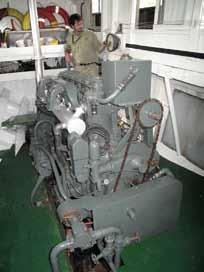
australians are fortunate in having a number of former Royal Australian Navy (RAN) vessels preserved in museums around the country. Many of them have sailed through major eras in Australian and world history and, as time marches on, they become large-scale, tangible survivors of these historical events.
Preserving this heritage is a daunting task. The ships are historic artefacts in their own right and their preservation requires an investment of considerable financial, industrial and human resources on a regular basis. As the years go by, restoration becomes increasingly more difficult as sources of spare parts dry up. However, with the advent of 21st-century technologies and methods comes a great advantage. The proliferation of computer-based systems and the internet have revolutionised communication and now provide an avenue for the diffusion of ideas and information, and locating materials. Museum ship managers can access a wealth of knowledge from around the world in the care of their ships.
The largest concentration of ex-RAN vessels is held by the Australian National Maritime Museum here in Darling Harbour, Sydney. Afloat in the museum’s precinct are the 119-metre Daring class destroyer HMAS Vampire, the 90-metre Oberon class submarine HMAS Onslow and the 33-metre Attack class patrol boat HMAS Advance. We also use a 12-metrelong officers’ launch MB 172 for transporting museum personnel and guests on Sydney Harbour. The museum also moors, displays and maintains one of the most famous vessels of World War II, the commando raider Krait – veteran of the successful Operation Jaywick attack on Singapore harbour in 1943 – on behalf of the Australian War Memorial.
Both Vampire and Onslow are open to the public all year round – unavailable only when undergoing dry docking every five years or so for major maintenance, a regular and costly, but vital, exercise. Vampire is the largest museum object displayed anywhere in Australia. Volunteers have been trained to take guided tours through the destroyer at regular times throughout the day. They include a number of veterans of RAN service on the ship during its operational life 1959–1986. More than 19,000 visitors took advantage of this free service in 2009–2010. Thousands more wandered on their own through the ship from the upper deck through to the signal deck, finding out about life onboard,
viewing the crucial workings of the ship, enjoying audio visuals highlighting Vampire’s career and listening to recordings of former Vampire sailors’ experiences at sea. The popular ‘Action Stations’ light-and-soundscape in A Gun Bay fascinates visitors with its recordings of a loading and firing sequence of the 4.5-inch ‘big-gun’ turret.
The submarine Onslow, active from 1969 to 1999, offers a wonderful opportunity for the museum’s younger visitors with an average 200 schools per year booking our Submarine Adventure or Science and the Sea workshops. Visitors learn how the Oberons used stealth, endurance and agility to undertake secret patrols, photographic reconnaissance, surveillance, shadowing and intelligence gathering in the Cold War period.
These floating naval vessels continue to serve by regular association with the RAN dive team, assisting with the training of Navy divers, and recently Vampire supported the Army with bomb training on board. Both Vampire and Onslow receive annual visits from the midshipmen of the Royal Australian Naval College, HMAS Creswell
While the propulsion systems of the destroyer and submarine have been decommissioned, the patrol boat Advance is still fully operational (except of course for its 40 mm Bofors gun) and can put to sea as required, continuing to take part in community and naval events. During its service life from 1968 to 1988, Advance was active in controlling illegal fishing, smuggling and immigration, undertaking search and rescue and occasional inshore survey work. It also moonlighted for a while as the star of ABC-TV’s adventure series Patrol Boat, the precursor of today’s patrol boat drama featuring the latest Armidale class vessels.
The state of South Australia preserves three very different types of naval vessels. The South Australian Maritime Museum in Port Adelaide is home to the Archie Badenoch, built in 1942 as a supply-tender motor vessel for the RAN. It now offers Port River cruises for school groups and holiday makers. The tugboat Nabila was built towards the end of World War II as AT 2239, and was used to tow supply barges among the island groups around Papua New Guinea. It now proudly resides at The Axel Stenross Museum at Port Lincoln. Permanently landlocked in Whyalla is the town’s namesake HMAS Whyalla, a Bathurst class antisubmarine and mine sweeping vessel
above: museum shipwright operates the gardner diesel in the World War ii commando raider Krait, owned by the australian War memorial and operated, maintained and conserved by the australian National maritime museum. the engine has been in service since the vessel’s famous raid on occupied Singapore. photographer J mellefont/aNmm
Sig N al S 96 September t O N O vember 2011 19
left: australian-built World War ii river class frigate HmaS Diamantina was one of the first ex-raN vessels to be preserved as a museum ship, and is now displayed at the Queensland maritime museum. raN photograph
The largest concentration of ex-RAN vessels is held by the Australian National Maritime Museum
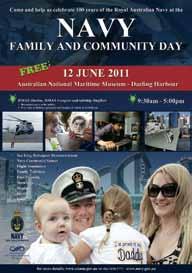
100 years Navy Day
to celebrate one hundred years of the royal australian Navy, the australian National maritime museum staged a number of events and activities for visitors. a free navy family and community day included spectacular Sea King helicopter demonstrations and clearance diver tank displays, a lecture ‘ t he genesis of the raN’ by John perryman CSm, senior naval historical officer from the raN Sea power Centre, and the raN band sunset ceremony on the museum forecourt next to our ex-raN ships. it was followed in July by a wardroom dinner on museum destroyer HmaS Vampire, and a special seminar ‘100 years of the raN’ with speakers from the Navy and Naval Historical Society. a s well our members enjoyed a tour of the raN’s Spectacle island, formerly a gunpowder and naval munitions store and more recently a repository of raN heritage items.
(more commonly known as a corvette). Whyalla was built by BHP at their Whyalla shipbuilding yard in 1940 and was launched in 1941. Today the ship has a new role – representing the long shipbuilding history of the region as well as the RAN’s World War II operations in the Pacific and New Guinea.
Sixty corvettes were built during World War II in Australian shipyards as part of the Commonwealth Government’s wartime shipbuilding program, and the RAN corvettes were named after Australian country cities and towns. In Williamstown on Port Phillip Bay in Victoria another corvette bears testimony to the resilience of naval history aficionados. The former HMAS Castlemaine has been painstakingly restored with parts gathered from corvettes scrapped in Australia and New Zealand. She is operated by the Maritime Trust of Australia and a team of willing volunteers who both maintain the ship and offer on-board tours and information on the weekends.
In 2002 the Western Australian Museum built a new maritime museum on Victoria Quay and has utilised Fremantle’s historic World War II submarine slipway to display its own Oberon class submarine HMAS Ovens out of the water. Guided tours offer visitors an opportunity to find out what life was like aboard a submarine with the added bonus of learning about Fremantle’s secret wartime history. Ovens serves as a living memorial to all submariners and to those who gave their lives while serving from Fremantle during World War II.
In Queensland the 86-metre River class frigate HMAS Diamantina was one of the first ex-RAN vessels to be preserved as a museum ship. The Queensland Maritime Museum in Brisbane is now home to this last survivor of some 150 of the class built worldwide for service in World War II – a fine testament both to Australian shipbuilding and the will to keep our naval history alive. Also at QMM is the tug Forceful. Requisitioned in 1942 and commissioned into the RAN, Forceful operated out of Fremantle and Darwin until late 1943. Preserving museum ships is a costly exercise and keeping them in working order is even more financially draining, as the Queensland Maritime Museum found out. The cost of maintaining Forceful’s seaworthiness became beyond the resources of the museum and it is now maintained as a floating exhibit at the museum’s wharf. Thankfully both vessels survived the raging Brisbane floods of 2011.
The most recent RAN ship offered for preservation as a museum ship is HMAS Townsville. One of 15 Fremantle class patrol boats built for the Royal Australian Navy, the boat is now in the care of the Townsville Maritime Museum and is awaiting funding to open it for public inspection. The Fremantles were the second class of Australian-designed and built patrol boats commissioned for the RAN after World War II, the first being the smaller Attack class, one of which – Advance, mentioned above – is here at the Australian National Maritime Museum. The largest of all, the Armidale class, are presently in service. Like our Advance, the Fremantle class Townsville came straight to the Townsville Maritime Museum after decommissioning and is in fine condition. As with most other museum ships, volunteers will be the core workforce operating and maintaining this vessel.
Returning to New South Wales and the country town of Holbrook near the Victorian border is the Holbrook Submarine Museum – dedicated to the role of the submarine and to Commander Norman Holbrook vc, a Royal Navy submariner of World War I. Located in the submarine precinct is one of the most unusual displays in Australia of a former RAN vessel: the Oberon class submarine, HMAS Otway. Its outer casing and conning tower rise from a park beside the Hume Highway as though it has navigated its way underground and emerged inland. Inside the museum building is Otway’s control room, which allows you to walk through and operate the periscope. The museum’s honorary curator came to the Australian National Maritime Museum recently as an intern, and you can learn more about this display in Currents on page 57.
Australian naval ships are not only preserved as museum ships. There are dozens of smaller vessels now in private hands that once served proudly in the Royal Australian Navy or during wartime for the Naval Auxiliary Patrol (NAP) or the Volunteer Coastal Patrol (VCP). Examples include the motor launch Seafarer that patrolled Perth waters for the NAP; the former HMAS Riawe that patrolled between Devonport and Low Head in Tasmania; and the yachts Wayfarer and Kathleen Gillett (the latter now owned by ANMM) which undertook night-time patrols of Sydney Harbour with the VCP. Many other vessels requisitioned for naval use survive today. The gaff-rigged ketch Hurrica V was renamed HMAS Stingray and operated
Sig N al S 96 September t O N O vember 2011 20

out of Port Moresby and Milne Bay. The tug Valiant was used by the US Army Small Ships in northern Australia.
A great many surviving vessels that have had a naval career of some kind can be found on the Australian Register of Historic Vessels (ARHV – www.anmm. gov.au/arhv). This online database operated by the Australian National Maritime Museum, in conjunction with colleagues from several maritime heritage organisations, records vessels of all types and sizes built up to 1965 that are relevant in various ways to Australia’s maritime heritage. It features information on their designers, builders and owners, as well as the social and geographical context in which they have existed. On the ARHV, vessels are used as the key to exploring their wider backgrounds.
Around the Australian coastline are the resting places of quite a few former RAN vessels. A section of one of the RAN’s very first ships, the destroyer HMAS Parramatta, lies on a bank of the Hawkesbury River just north of Sydney. The stern is located on the Parramatta
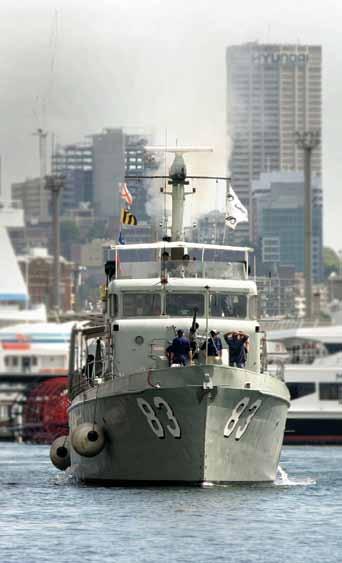
River near Silverwater while the bow section is on Garden Island, Sydney Harbour – leading to the joke: ‘Which was the longest ship in the RAN?’ Many more lie beneath the sea, some of them accessible to divers. The J class submarines of World War I were scuttled in Victorian waters in the 1920s after a short and disrupted period of RAN service. Two of these submarines are lying inside Port Phillip Bay, J3 at Swan Island and J7 at Sandringham, and four are to be found in the ships’ graveyard outside The Heads. In recent decades HMA Ships Derwent, Swan, Perth, Hobart, Brisbane, Canberra and Adelaide have been deliberately scuttled as artificial reefs and dive sites. While certainly not museum ships, these stripped vessels have not been completely lost to history as so many others have, but have undertaken new ‘duties’ in Australian waters.
The methods and aims of the many museums and organisations that care for Australia’s former naval vessels vary. It must be remembered that these ships, regardless of their current status, were
built as functional objects with a limited designed life. The naval ships featured here are often the largest and most complex moving objects in a museum’s collection, and are forever in the open. They are kept safe, with the aim of preventing or arresting deterioration, through various operational management plans. Ultimately all will have a finite lifespan dictated by the availability of resources – financial and human – of the museums managing them. Those naval ships preserved around Australia deserve our attention and enjoyment. Visit one today.
above left: Cold War warships the Daring class destroyer HmaS Vampire and Oberon class submarine HmaS Onslow at the australian National maritime museum give visitors rare access to the working and living spaces of these fighting vessels. photographer a Frolows/aNmm
above right: aNmm’s 1960s attack class patrol boat Advance is one of australia’s very few operational ex-raN vessels, kept navigable since being handed over by the Navy at the end of its operational life in 1988. photographer a Frolows/aNmm
Sig N al S 96 September t O N O vember 2011 21
Tampa and Siev X ten years on
ten years since mv Tampa rescued 433 asylum seekers, and 353 more drowned when a people-smuggling boat called Siev X sank near indonesia, the question of unauthorised boat arrivals is just as contested, divisive and relevant as it was then, writes Kim Tao, curator of post-Federation immigration.
It is hard to believe that this year marks the 10th anniversary of the MV Tampa rescue and sinking of SIEV X in 2001. These incidents inflamed political and public debate about refugees, asylum seekers and border protection at the turn of the 21st century. Ten years on they remain defining moments in Australia’s recent maritime and immigration history.
The theme of past and present government immigration policies is a key area identified in the Australian National Maritime Museum Collection Development Policy. The museum is acknowledging the anniversary with two displays of collection material acquired in the last decade: The Tampa crisis and X for unknown – SIEV X memorial designs
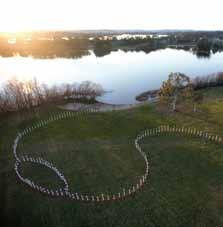
The Tampa crisis includes a life jacket and lifebuoy that were on board the Norwegian cargo ship when its crew rescued 433 asylum seekers from their stricken fishing boat, KM Palapa 1, in the Indian Ocean on 26 August 2001. Although Tampa was not licensed to carry more than 50 people its captain, Arne Rinnan, changed course to help the asylum seekers, who were mainly from Afghanistan which was then under Taliban rule.
Under pressure from some of the desperate asylum seekers Captain Rinnan headed for the offshore Australian territory of Christmas Island, but was denied permission to enter Australian waters. When the health of some passengers deteriorated Captain Rinnan sent a Mayday signal and sailed toward Christmas Island. Tampa was boarded by Australian special forces who ordered the ship turned around.
Following an intense political stand-off the asylum seekers were transferred to HMAS Manoora. Most were taken to the Pacific island of Nauru as part of Australia’s ‘Pacific Solution’ (2001–08). This aimed to prevent refugees from reaching Australian territory, where they
could legally claim asylum, to detain and process them offshore in cooperating countries. A small number of asylum seekers from Tampa were eventually granted refugee status and resettled in Australia.
In 2003 Tampa’s operator Wallenius Wilhelmsen Logistics donated a ship’s life jacket and lifebuoy to the museum. They represent the tension between international obligations for safety of life at sea (SOLAS) and Australia’s domestic policy on refugees and asylum seekers.
The Tampa crisis attracted extensive media coverage in Australia and overseas, dominating headlines and talkback radio. In contrast to this highly publicised incident, there is no confirmed visual documentation of the ill-fated vessel that came to be known as SIEV X (Suspected Illegal Entry Vessel Unknown). This was a decrepit, overcrowded fishing boat that embarked from Sumatra, Indonesia, on 18 October 2001, also headed for Christmas Island with over 400 asylum seekers who had fled Iraq and Afghanistan. The boat foundered the next day, drowning 353 people – 146 children, 142 women and 65 men.
According to survivors more than 100 people remained alive in the water that night when two vessels arrived and shone searchlights, but failed to rescue anyone. The vessels have never been identified. Only 45 people were eventually rescued, by passing fishermen.
Controversy still surrounds the sinking, but despite a number of Australian Senate motions a full independent inquiry into the tragedy has yet to be held.
Many of the SIEV X victims were women and children trying to reunite with husbands and fathers in mandatory detention or on Temporary Protection Visas (TPVs) in Australia. Mandatory detention of unauthorised arrivals began in 1992 under the Labor government (1983–96). In 1999 the Coalition
above: the Siev X memorial, based on mitchell Donaldson’s design, comprises 353 decorated wooden poles stretching over 300 metres in Weston park, Yarralumla. photographer belinda morgan pratten 2007. reproduced courtesy Siev X National memorial project opposite: life jacket and lifebuoy on display in The tampa crisis. aNmm Collection gift from Wallenius Wilhelmsen logistics. photographer a Frolows/aNmm
Sig N al S 96 September t O N O vember 2011 22
government (1996–2007) introduced TPVs for unauthorised arrivals who had been assessed as genuine refugees. This new type of visa removed their rights to be joined by family or to re-enter Australia if they needed to leave.
These were among tougher policies implemented by successive governments since the era of Vietnamese boat people in the 1970s, whose arrivals were more readily accepted. Recent Labor governments (2007 to present) have modified some policies and introduced new ones in the attempt to neutralise one of the most polarising debates in contemporary Australian society – how to deal with asylum seekers arriving on unauthorised voyages.
The museum has a rich collection linked to refugees from the war in Indochina, including the 1975 Vietnamese refugee boat Tu Do. We also hold a growing collection relating to asylum seekers and people smuggling which includes political cartoons; material associated with illegal Chinese immigrants on Kayuen in 1999; flags, banners and letters from the 2004 Flotillas of Hope protest expedition to Nauru; and student designs for the national memorial to SIEV X in Canberra.
The concept for the memorial emerged through a nationwide art project coordinated by a group of friends from the Uniting Church. In 2003–04 students from more than 200 high schools learned about SIEV X and responded with designs for the memorial, now installed on the shores of Lake Burley Griffin. Their designs captured a range of feelings –empathy for the plight of young refugees, anger at the nation’s treatment of asylum seekers and disbelief at the scale of loss of life. A selection of these designs, including the winning concept by Brisbane student Mitchell Donaldson, is displayed in X for unknown – SIEV X memorial designs
In the process of selecting works for the exhibition I had to remind myself the designs were created by students in Years 9 and 10. They are provocative, thoughtful and highly symbolic, reflecting a powerful emotional and intellectual engagement with the story of SIEV X and a depth of compassion that appears to be sadly lacking in many adults. The designs are compelling because they represent children’s perspectives on issues of asylum seekers, refugee policy and human rights. As current political debate once again centres on offshore solutions for asylum seekers, it is clear these issues remain as contested, divisive and relevant as they were 10 years ago.

Sig N al S 96 September t O N O vember 2011 23
museum celebrates twenty years
On 29 November 2011 it will be exactly 20 years since the australian National maritime museum opened to the public, and we’re inviting you to celebrate along with us!

a series of events and activities will be occurring to evoke memories of the museum past and present –to reflect on our achievements and look to our future. Join the 20th birthday party!
20 years – a snapshot
t his photographic exhibition opening on 26 November in our South gallery and tasman gallery commemorates highlights from the past 20 years, from royalty to rock stars, vessels to vikings, from behind the scenes to the big blockbuster shows. and with it we are inviting the public to share their own memories of the museum with a photographic competition.
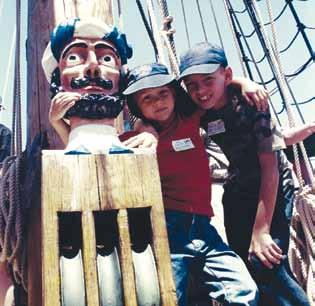
museum moments photographic competition
Share your museum moments in our 20th anniversary photographic contest. anyone can enter! Submit images past and present online or via post, with a short byline and contact details. entrants will go on Flickr. Categories include ‘best photo overall’; ‘Contemporary aNmm 2010–2012’; ‘past aNmm 1988–2009’. a panel of three judges including staff photographer andrew Frolows will determine the prize winners in each category. prizes will include a Digital Slr valued at $4,000 for best photo. Winners will be announced in mid 2012. information at www.anmm.gov.au/20years
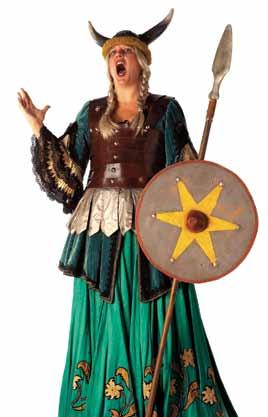
Sig N al S 96 September t O N O vember 2011 24
100 stories from the australian National maritime museum
Now in production, this luxurious book will celebrate both the museum’s 20th-anniversary year and 25 years of the australian National maritime Collection. published in partnership with the University of New South Wales press, the 250-page, full-colour volume will appear in both hard copy and e-book format and will be distributed nationwide. From our first to our most recent acquisitions, the stories they tell are variously fascinating, curious, poignant or exuberant, but all resonate with a sense of time, place and human interaction.
20th members anniversary lunch
an anniversary lunch on Sunday 27 November will be hosted by museum director mary-l ouise Williams and chairman peter Dexter, and will feature guest speaker media personality and author mike Carlton. it offers the good company of fellow members and a delicious three-course lunch from the museum’s caterer l aissez Faire, accompanied by Coral Sea wines. t he annual anniversary lunch is a fine tradition and gastronomic event, and on this anniversary it will be something to remember. For prices and booking details see page 31.

20 years 20 objects
a series of broadcast radio interviews will tell the stories behind 20 of the museum’s fascinating collection items as seen through the eyes of a curator and a conservator. t hese interviews will appear online as podcasts. Chosen from a collection of over 100,000 items, they will reflect the nature and diversity of the museum and its continuing aspiration of understanding, interpreting and engaging with our rich maritime history and culture.
20th anniversary gala dinner
to highlight the museum's need for ongoing community and sponsorship support we're holding a black tie dinner on tuesday 29th November – the museum's actual 20th anniversary. a couple of special features will include sunset drinks on the new ben l excen terrace and a special preview of the big summer aQUa exhibition. Corporate tables will be offered as sponsorship packages. prices are on application. For information contact Neridah WyattSpratt at the museum on 9298 3614.
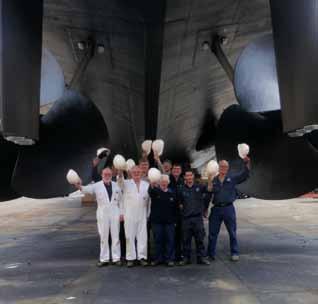
Foundation members and life members 20th anniversary cocktail party
t his evening function on t hursday 17 November hosted by the museum director mary-l ouise Williams and chairman peter Dexter is open to all Foundation and l ife members. (Foundation members are those who joined within the first year of the museum’s opening on 29 November 1991.) t here will be live music, refreshments, recollections of the museums first 20 years and previews of what’s planned for the future. For prices and bookings details see page 31.
20 year staff Christmas party
a special anniversary Christmas party will be held for present and past staff on t hursday 8 December.
above left to right:
in the beginning was … a metropolitan working port that was beginning to transform beyond all recognition. Clearing the ground for construction of the australian National maritime museum and the Darling Harbour precinct in 1986.
Send us your own museum memories … like this visit to the replica of the Dutch east indiaman Batavia at our wharves in the Olympic year 2000. We were very young and somewhat green when paul and linda mcCartney came to visit in 1993.
the museum’s shipwrights and vessel managers with our Daring class destroyer Vampire in the drydock at garden island in July 2010, on one of the ship’s periodical slippings to ensure that australia’s largest museum object is in top condition.
left: Our 2005–06 exhibition Vikings brought together a unique assemblage of artefacts from northern european museums – and saw staff curator lindl lawton transformed into our own version of brunhilde.
Sig N al S 96 September t O N O vember 2011 25

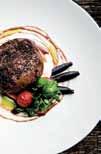

Enjoy your wedding ceremony or reception at our unique waterfront setting. Located on the western shore of Darling Harbour, the venues have splendid city skyline and harbour views.
Enjoy pre-dinner drinks on the decks of the HMAS Vampire before moving into the glassed Terrace Room.

Laissez-faire Catering, renowned for their innovative cuisine, along with delivering service of the highest standard, are the venue’s exclusive caterers.
T +61 2 9298 3625 venues@anmm.gov.au www.anmm.gov.au/weddings


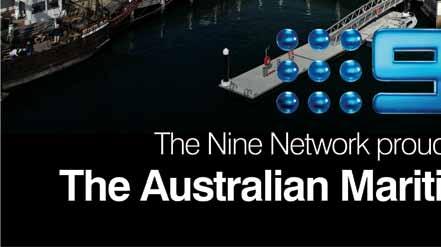

Photos: bottom Blumenthal Photography; top Wyatt Song, Moments in Time Sig N al S 96 September t O N O vember 2011 26
members
News
australian geologist Frank Debenham, introduced by pulitzer prize-winning author professor edward larson who, with gastronomic academic Diana Noyce, debated the achievements of Scott and amundsen at a members forum. Join the debate, ask ed or Diana a question, read a transcript of their talks … all on the museum’s blog http://anmm.wordpress.com/

twenty great years for our members
Happy 20th Birthday! The Australian National Maritime Museum is celebrating 20 years since the doors first opened to great fanfare on 29 November 1991. Our collection and facilities have grown immensely over those years and so has our Members program … from 1,317 Members in the first year we now have over 7,500.

the raN’s centenary at the annual dinner on museum destroyer Vampire:
t he members program has had some great highs creating a bundle of happy memories for many of you. it brought you the inimitable solo circumnavigators Kay Cottee and Jessica Watson, as well as controversial guest speakers such as gavin menzies whose book 1421 proposed the Chinese discovery of everything. We celebrated such milestones as the 200th anniversary of the battle of trafalgar and our destroyer HmaS Vampire’s 50th birthday. You toured interstate and overseas on our memorable maritime itineraries, and were invited on board amazing vessels such as the giant aircraft carrier USS Kitty Hawk and Dutch e ast indiaman replica Batavia and adding value to our major exhibitions, you enjoyed intimate curator previews and insightful seminars delivered by top experts. t here are far too many highlights to recall here … but we’re encouraging you to reminisce with us and send us your thoughts and photos of favourite moments at the museum. You can find out how and read more about what we have in store on pages 24–25. above all, we invite you to join in the revelry of the 20 year celebrations!
enjoy the camaraderie and the culinary feast of the 20th anniversary members lunch. t his year the guest speaker will be the compelling, witty and often controversial media personality and author mike Carlton. Foundation members (those who joined in the first year the museum opened) and l ife members are invited to a cocktail party on the deck of HmaS Vampire, hosted by the director mary-l ouise Williams and chairman peter Dexter. See the following pages for our other great spring program activities. You can meet authors, scientists, a culinary historian, curators, shipwrights, a ferryman and the odd pirate! and now i have to pass on some words of farewell from our long-standing members manager adrian adam, who recently left the museum to pursue a career opportunity elsewhere. adrian was well known to many of you and i’m sure you join me in thanking him for the dedication, energy and attention to detail he brought to the job – and the long hours he put in on so many weekends! adrian said: ‘Over 10 satisfying years it was a great honour to work for such a prestigious museum and its loyal and supportive members. i will miss the many events and activities that brought me in touch with so many of you and wish you all the very best for the future … and trust you continue to support the museum in the years ahead.’
See you at the museum soon!
Claire
palmer, acting members manager
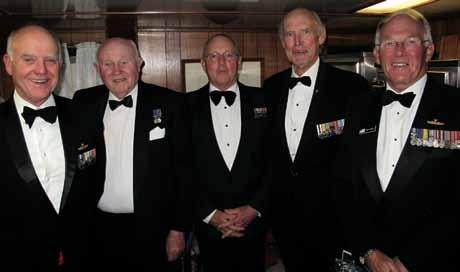 marking
CmDr Chris bolton raN (rtd), lt-Commander Harry Howell rNr, anthony White raN (rtd), John murray raN (rtd), CmDr rob everrett raN (rtd). photographer a adam/aNmm
marking
CmDr Chris bolton raN (rtd), lt-Commander Harry Howell rNr, anthony White raN (rtd), John murray raN (rtd), CmDr rob everrett raN (rtd). photographer a adam/aNmm
right: i mage from Scott’s Last Expedition published US a 1913 Sig N al S 96 September t O N O vember 2011 27
members John and bonita Heffill relax in the members lounge after a members ferry trip to view Sydney Heritage Fleet’s ship dock in blackwattle bay. photographer C palmer/aNmm
members events
Calendar Spring 2011 September
Sunday 18 Farewell Scott triple bill: antarctic expeditions, conservation and a fragile future
monday 19 For kids: talk like a pirate Day – Swashbuckled! and treasure hunt
Sunday 25 Talk: ‘Navy divers’ with gregor Salmon
Wednesday 28 On the water: Chowder bay and marine institute October
tuesday 4 Talk and cruise: ‘the restoration of Epic Lass’
thursday 6
Friday 14
Lunchtime talk: ‘Admiral Arthur Phillip’ with lyn Fergusson
Lunchtime curator talk and tour: Scott’s last expedition
Saturday 15 On the water: Spring garden cruise
thursday 20 Tour: garden island naval heritage
Sunday 30 Talk: ‘a history of Sydney ferries’ with bill allen
November
Friday 4 For teens: Seamanship skills and 17th-century sailing
Saturday 5 For teens: Seamanship skills and 17th-century sailing
Sunday 13 Talks: ‘maritime art, ships paintings and cruise ships’
thursday 17 Special: Foundation and life members cocktail party
Friday 18 Tour: Wharf 7 behind the scenes
Sunday 27 Special: members lunch with mike Carlton
How to book
it’s easy to book for these members events… have your credit card details handy:
• book online at www.anmm.gov.au/ membersevents
• contact the Members office: phone (02) 9298 3644 (business hours) or email members@anmm.gov.au bookings strictly in order of receipt
• if paying by mail after making a reservation, please include a completed booking form (on reverse of the address sheet with your Signals mailout) with a cheque made out to the australian National maritime museum
• if payment is not received seven days before the event your booking may be cancelled
Booked out?
We always try to repeat the event in another program.
Cancellations
if you can’t attend a booked event, please notify us at least five days before the function for a refund. Otherwise, we regret a refund cannot be made. events and dates are correct at the time of printing but these may change…if so, we’ll be sure to inform you.
Parking
Wilson parking offers members discount parking at nearby Harbourside Carpark, murray Street, Darling Harbour. to obtain a discount, you must have your ticket validated at the museum ticket desk.

Farewell Scott triple bill Antarctic expeditions, conservation and a fragile future
1.30–5.30 pm Sunday 18 September at the museum
Farewell Scott 1
‘Robert Falcon Scott and a Tasmanian connection! Was he here?’
patrick g Quilty am, former director of the australian antarctic Division it is generally believed that Scott never visited tasmania, but he spent an afternoon in 1901 on macquarie island. Yet there is so much more … at the time his death was announced, his sister was the wife of the governor of tasmania and his mother and another sister were resident at g overnment House.
professor Quilty (School of e arth Sciences and institute for marine and antarctic Studies, University of tasmania, and former Chief Scientist with the australian antarctic Division) will give his assessment of Scott’s place in antarctic exploration.
Farewell Scott 2
‘The conservation of Heroic Era Huts in Antarctica’
Stirling Smith, mawson’s Huts Foundation
Stirling Smith is a Sydney-based archaeologist and heritage consultant who undertakes work on maritime, historic and aboriginal sites. He recently returned from antarctica where he worked as archaeologist for the mawson’s Huts Foundation 2010–11 e xpedition. He will share his story and speak on the heroic era of antarctic exploration.
left: © New Zealand a ntarctic Heritage t rust Sig N al S 96 September t O N O vember 2011 28
Scott’s base camp hut at Cape evans today



Farewell Scott 3
‘Scott’s Antarctic 100 years on: Challenges, opportunities and its future’ professor michael Harte, World Wide Fund for Nature australia
One hundred years ago, the antarctic Scott knew was a harsh, unforgiving and remote place. in 2011, antarctica is inextricably linked to the rest of the world and its isolation no longer insulates it from global economic and environmental forces. it remains a place of immense opportunity, a place where the best of global cooperation, science and technology are readily demonstrated.
professor michael Harte (Oregon State University, USa , and World Wide Fund for Nature australia) compares the past, present and future of antarctica through the lens of conservation. Ultimately he tells an uplifting story of success and hope in the face of old and new challenges.
members $30, general $40. includes afternoon tea and evening reception with Coral Sea wines
For kids
Talk like a Pirate Day Swashbuckled! and treasure hunt
5.15–7.30 pm Monday 19 September at the museum
Come on a treasure hunt through the museum after dark with our resident pirate, grognose Johnny, and learn how to talk like a pirate! Step aboard the 17th-century vessel Duyfken tuck into a pizza dinner, then watch a special preview performance of the new theatre show Swashbuckled! members child $25, general $35. includes pizza, refreshments and theatre show. Come dressed in your best Jack Sparrow outfit! Children will be fully supervised (parents and carers not required to stay). a ges 5–12 years
talk
‘Navy divers’ with Gregor Salmon
3–5 pm Sunday 25 September at the museum
t he australian clearance diver is one of the most respected and versatile operators in the military sphere. t heir story goes back to WWii, when Hitler’s secret weapon – the magnetic mine – had britain on her knees. Four extraordinary aussies were among the brave naval volunteers who tackled Nazi mines on land and under water. t he men who have followed in their footsteps share the same brand of courage. From the rivers of vietnam to the deserts of afghanistan, Navy divers have excelled under the most extreme pressure, yet we know very little of their heroic deeds. Join author gregor Salmon to hear their incredible story.
members $15, general $20. includes Coral Sea wines and refreshments on board
HmaS Vampire
On the water
Chowder Bay and Sydney Institute of Marine Science
10 am–2 pm Wednesday 28 September at Chowder Bay
t he Sydney institute of marine Science at Chowder bay is a collaborative research and training centre that brings together scientists from six New South Wales universities plus state and federal marine and environmental agencies. it conducts multidisciplinary research on the impact of climate change and urbanisation, biological diversity, fisheries, tourism, coastal development and marine disease. enjoy a cruise to Chowder bay and explore the institute with SimS representatives. t hen take a stroll around Chowder bay and learn about its history with your Harbour trust guide.
members $50, general $60. includes light lunch and refreshments. meet next to HmaS Vampire to board ferry
EMAIL BULLETINS
Have you subscribed to our email bulletins yet? Email your address to members@anmm.gov.au to ensure that you’ll always be advised of activities organised at short notice in response to special opportunities.
right: Canterbury m useum NZ centre: p hotographer a a dam/ a N mm far right: p hotographer J m ellefont/ a N mm
Terra Nova the Scott expedition ship
grognosed Johnnie and the pizza kids
Sig N al S 96 September t O N O vember 2011 29
tranquil Chowder bay
members events



lunchtime talk and cruise
‘The restoration of MB 172’ 12 noon–1.30 pm Tuesday 4 October
mb 172 is an elegant timber 1937 naval motor launch that once carried naval officers and vips. built by the royal australian Navy at Sydney’s garden island Naval Dockyard in 1937, it spent most of its working life in Darwin. t he vessel has retained its official Navy pennant number (mb 172) but for some years was named for a museum sponsor, taubmans industries ltd (epiglass australia). Join aNmm fleet manager phil mcKendrick and shipwright Jeff Hodgson for an illustrated talk about the launch’s most recent restoration over a light lunch, then step aboard for a 20-minute motor in the Darling Harbour precinct. members $20, general $30. includes light lunch and refreshments. Strictly limited places
lunchtime book talk
‘Admiral Arthur Phillip, the Man’ with Lyn Fergusson
12 noon–1.30 pm Thursday 6 October at the museum
We all know about arthur phillip – admiral of the royal Navy and first governor of New South Wales – but what sort of man was he? phillip lived to the age of 76, but spent only four years, 10 months and 15 days in Sydney town and the young colony of New South Wales. How did he spend the other years of his life? What experiences shaped the man destined to lead the First Fleet and act as guardian to hundreds of convicts in 1787–1788? lyn Fergusson’s revealing biography, Admiral Arthur Phillip, the Man, fills in the gaps.
members $15, general $20. includes light lunch and refreshments
lunchtime curator talk and tour Scott's last expedition
12 noon–1.30 pm Friday 14 October
BOOKINGS AND ENQUIRIES
Booking form on reverse of mailing address sheet. Please note that booking is essential: online at anmm.gov.au/membersevents or phone (02) 9298 3644 (unless otherwise indicated) or email members@anmm.gov.au before sending form with payment. All details are correct at time of publication but subject to change.
Come and view this international travelling exhibition that explores Captain robert Falcon Scott’s tragic second expedition to antarctica, from which he never returned. Join senior curator l indsey Shaw for a talk and guided tour of this outstanding exhibition, which looks at the expedition from exciting new angles and celebrates its achievements.
members $10, general $20. includes Coral Sea wines and a light lunch

On the water
Spring garden cruise
11 am–2.30 pm Saturday 15 October on Lane Cove River
t he spring garden holds many delights including jacarandas in bloom. and there’s no better way to see them than on a leisurely cruise up the l ane Cove river aboard historic ferry Lithgow adam Woodhams, award-winning gardener and photographer, will provide expert botanical and historical commentary. t his is one of our most popular annual events, so book early!
members $45, guests $55. includes brunch on board. meet at the Festival pontoon next to submarine Onslow tour
Garden Island naval heritage
10 am–1.30 pm Thursday 20 October at Garden Island
Don’t miss this opportunity to enjoy a behind-the-scenes guided tour of garden island heritage precinct with representatives of t he Naval Historical Society of australia. We will visit areas within the secure precinct, including the Kuttabul memorial, the chapel, and heritage buildings such as the original boatshed and the top of the Captain Cook Dock. You will then have the option of taking a self-guided tour of the raN Heritage Centre.
members $25, general $30. includes guided tour, entry to raN Heritage Centre, morning tea (does not include ferry trip to garden island). Some walking and climbing of stairs required. Catch the 10.10 am Watson’s bay ferry from Circular Quay to garden island
far left: p hotographer a Frolows/ a N mm centre: e ngraving W Sherwin a N mm Collection left: p hotographer J m ellefont / a N mm
mb172 in museum workshop
arthur phillip esq
Sig N al S 96 September t O N O vember 2011 30
Navy whaler at garden island

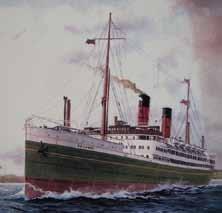

talk
‘A history of Sydney ferries’ with Bill Allen
2–4.30 pm Sunday 30 October at the museum
Noted ferry historian, researcher and collector bill allen will share his rare collection of images of Sydney ferries of yesteryear in this two-part presentation. Hear about the history of the manly ferry run and the many ferries that made the crossing over the years, including the 1880s paddle steamer Brighton and later the South Steyne, Curl Curl and Dee Why. t hen explore the history of the Sydney Harbour river runs and the ferries that plied the l ane Cove and parramatta rivers, including the Lady Chelmsford and Lady Denman
members $20, general $30. includes Coral Sea wines and refreshments
For teens
Seamanship skills and 17th-century sailing
5.30–7.30 pm Friday 4 and Saturday 5 November
Come aboard the 17th-century jacht Duyfken, a reconstruction of early explorer Willem Janszoon’s Dutch e ast-india Company vessel, and learn about life aboard a square-rigged ship with shipkeepers mirjam Hilgeman and andrew bibby. l earn the basics of seamanship, including rigging, knotting, splicing, watch-keeping, taking the helm and even cooking in the galley with historic culinary expert l ouise l athouwers.
members $55, general $65. includes a one-hour theory session, two one-hour hands-on sessions and a one-hour culinary skills talk and dinner. Strictly limited places. Suitable for ages 12+
talks
‘Maritime art, ship paintings and cruise ships’ with Stan Stefaniak and Peter Plowman
2–5 pm Sunday 13 November at the museum
Come to this special double bill with marine artist Stan Stefaniak and maritime historian and author peter plowman. Hear about the heyday of maritime art in the 19th century, and its later development as poster art, postcards and commissions for shipping companies, then find out how a contemporary marine artist approaches his work, with illustrated examples. Stan will discuss a selection of his paintings of australian coastal ships, migrant ships, liners, cruise ships and cargo vessels, and peter will give an insight into the history of some of these famous ships. members $15, general $20. includes afternoon tea, Coral Sea wines and refreshments
Special
Foundation and Life Members
20th anniversary cocktail party
5.15–7 pm Thursday 17 November at the museum
Foundation and l ife members are invited to join director mary-l ouise Williams and chairman peter Dexter for this special event to celebrate the museum’s 20th anniversary. enjoy live music, refreshments and canapés, and hear recollections of the museum’s first 20 years as well as plans for the future.
members $35, guests $65. meet in the museum foyer
tour
Wharf 7 Heritage Centre behind-the-scenes
10.30 am–1 pm Friday 18 November at Wharf 7
Come behind the scenes in our special Wharf 7 storage areas that are usually closed to the public, and view objects from the National maritime Collection in the special storage rooms. visit our preservation laboratory where conservation manager Jonathan l ondon will explain how artefacts are preserved and prepared for exhibition, then view some of the treasures from the vaughan evans library. members only, $15. includes light lunch. l imited places. meet in Wharf 7 foyer
Special
20th Members anniversary lunch
11.30 am–2.30 pm Sunday 27 November in the Terrace Room at the museum book early for our next anniversary lunch with museum director mary-l ouise Williams, Council chairman peter Dexter, and special guest speaker, media personality and author mike Carlton. enjoy the good company of fellow members and a delicious threecourse lunch from l aissez-faire, our award-winning caterers, accompanied by Coral Sea wines. t he annual anniversary lunch is a fine tradition and gastronomic event … don’t miss it!
members $90, guests $105. meet in the museum foyer
Ferry Kulgoa, William Hall glass plate
Aorangi by Stan Stefaniak
right: a N mm Collection centre: collection of ther artist far right: p hotographer J m ellefont / a N mm Sig N al S 96 September t O N O vember 2011 31
Wharf 7 maritime Heritage Centre
What’s on spring 2011 events
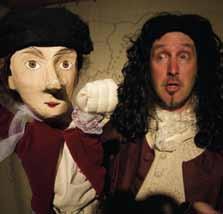


the spice race
Swashbuckled!
A tale of a curious captain (ages 5–12)
During school term
Mon 12–Friday 16 September Mon 19–Thursday 22 September
During school holidays
Mon 26 Sept–Sat 8 Oct (except Sun 2 Oct)
Three shows a day (for times see www.anmm.gov.au/swashbuckled)
Swashbuckled! explores the adventures, disasters and discoveries of Captain William Dampier as he sails on his ship The Roebuck from england to australia, and his treacherous attempts to return home. a show for all ages and great for school groups.
presented by Spare parts puppet t heatre. $7. group discounts available on request. bookings 9298 3655 or bookings@anmm.gov.au
Auslan tour of Scott’s last expedition
Saturday 3 September 11 am–12 noon
auslan interpretation will be available for this curator-led talk and tour of Scott’s last expedition with aNmm senior curator l indsey Shaw. t his outstanding international travelling exhibition explores Captain robert Falcon Scott’s tragic second expedition to antarctica, from which he never returned. F ree bookings essential 9298 3655 or bookings@anmm.gov.au
Conserving our Antarctic heritage
Wednesday 12 October 10 am–12.30 pm
grab this opportunity to view Scott’s last expedition before it leaves our shores.
Hear Julian bickersteth (international Conservation Services) talk about conserving antarctic material. after morning tea discover the highlights of the exhibition with senior curator l indsey Shaw.
$45. includes morning tea. bookings Wea 02 9267 6988
Sunset sustainable seafood on HMAS Vampire
Wednesday 19 October 6.30–9.30 pm
a s part of Crave/Sydney international Food Festival, this event offers a unique opportunity to enjoy a superb dinner showcasing australian sustainable seafood on the decks of the iconic HmaS Vampire
With a menu created by chef tom Kime from Fish & Co (author of Fish Tales) and catering by l aissez-faire, this will be an evening not to be missed. Supported by the australian marine Conservation Society, producers of australia’s Sustainable Seafood guide.
$75/ members $65. bookings essential: 9298 3655 or bookings@anmm.gov.au or book online
The spice race
Thursday 10 November 10 am–12.30 pm
Join food enthusiast and U3a lecturer Heather bentley as she explores stories about the 17th-century spice race: pirates, buccaneers, scurvy, sugar and rum! ian burnet, author of Spice Islands, shares the fascinating history of the Dutch United e ast india Company. take a guided tour of Duyfken, replica of a Dutch e ast india Company vessel, followed by a morning tea of spice-inspired treats.
Cost $55 bookings Wea 02 9267 6988
Program times and venues are correct at time of going to press. To check programs before your museum visit call 02 9298 3777.
Special group rate for school holiday activities page 33
For 10 or more children, $7/child for a fully organised program of activities including:
• all museum exhibitions
• all children’s daily activities
• entry to destroyer HMAS Vampire and submarine HmaS Onslow
• FREE entry for 2 adults/ 10 children
• FREE bus parking
Nb $4 extra/child for 1874 tall ship
James Craig bookings essential. book early to ensure your space! ph 9298 3655 Fax 9298 3660 email bookings@anmm.gov.au
Sunset sustainable seafood on Vampire Swashbuckled!
Sig N al S 96 September t O N O vember 2011 32
Kids events
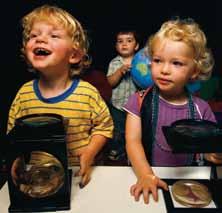


During term
Family fun Sundays
Kids on Deck
(ages 5–12)
Every Sunday during term 11 am–3 pm (hourly sessions)
Epic explorers!
(except 18 September)
antarctic sledge-race interactive games. Craft a mobile, flag or explorer goggles. Pirates!
Sunday 18 September
Join in the international talk l ike a pirate Day celebrations in Kids on Deck.
Kids on Deck $7 child or F ree with any purchased ticket. adults/ members F ree
Mini Mariners
(ages 2–5 + carers)
Every Tuesday during term 10–10.45 am and 11–11.45 am September – Boats in the Harbour October – Fun in the Sun November – Pirates Ahoy!
$7 child. members 1 adult F ree playgroups welcome (online bookings essential)
Cabinet of curiosities touch trolley
Every Sunday during term 11 am–12 noon & 2–3 pm
Discover amazing artefacts on this interactive discovery device in our galleries. touch and experience objects from the museum’s education collection and hear the stories behind them.
F ree
Family events
Torchlight tour and orienteering adventures in Scott’s last expedition
5–7 pm Sunday 11 September
grab your torches and tents and join in this interactive after-hours tour with a ghostly polar explorer guide. Undertake orienteering challenges and hunt for hidden supplies as you explore Scott’s last expedition Set up camp in the tasman l ight gallery for antarctic-inspired refreshments!
$25 child $20 member child. Carers Free
Pirate treasure hunts and Swashbuckled!
5–7 pm Saturday 8 October
take in a special waterside performance of Swashbuckled! adventure on a pirate treasure hunt through the museum led by a pirate guide, followed by supervised games, craft and refreshments.
$30 child $25 member child
Spring
holidays
25 September–
9 October
Kids on Deck (ages 5–12)
Daily during holidays
10 am–4 pm (hourly sessions)
Go Dutch!
be inspired by our visiting Dutch vessel, Duyfken (l ittle Dove). Craft a windmill or some paper blumen (flowers), decorate a model of the Duyfken and paint a batik artwork. Discover exotic trade routes taken to the Spice islands of indonesia through interactive games.
$7 child or F ree with any purchased ticket. adults/ members F ree
Deliciously Dutch! Kids cooking workshops
Wednesday 28 September 10–11.30 am (5–7 years) 12–1.30 pm (8–10 years) 2–3.30 pm (10–12 years) l earn techniques and a recipe for Dutch sweet treats from a professional chef. prepare a dish to taste and take home. $15/ members $12. bookings essential
Theatrical things: props and set design workshop (ages 8–14 ) 11 am–2.30 pm Tuesday 4 October be inspired by a performance of Swashbuckled! Design and build spectacular props and sets using repurposed materials with the artists from Circus Solaris. $40/$35 members (includes Swashbuckled! ticket). bookings essential

Digital storytelling and film-making workshop
(ages 8–14)
10 am–2 pm
Thursday 6 and Friday 7 October
Create and edit your own short films and digital stories in this exciting 2-day workshop with CuriousWorks. l earn professional film-making and editing techniques as you are inspired by the museum’s galleries and vessels. Have your finished films screened at the museum in a special preview event for your families and friends.
$240/ members $220. e arlybird rates (book before 16 Sept) $200/ members
$180. bookings essential: 9298 3655 or email bookings@anmm.gov.au
Cabinet of curiosities
Swashbuckled pirates!
Digital film-making workshop
Sig N al S 96 September t O N O vember 2011 33
exhibitions


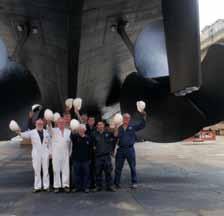
Scott’s last expedition
Until 16 October 2011
Gallery One, North Gallery and South Gallery
When Captain robert Falcon Scott set out on his second expedition – the british antarctic e xpedition 1910 – he could not have predicted it would be his last. He died on the return journey from the South pole two years later. public perceptions of Scott have varied greatly over the years, from national hero to flawed leader, and discussions of what really happened on that ill-fated journey still captivate our imagination.
to commemorate the centenary of the expedition, the Natural History museum (l ondon), Canterbury museum (Christchurch, NZ) and the New Zealand antarctic Heritage trust have collaborated to create this travelling exhibition. at the centre is a stylised representation of Scott’s expedition hut at Cape Evans. Original artefacts, equipment, personal effects and rare scientific specimens are displayed in australia for the first time.
t his groundbreaking exhibition goes beyond the powerful stories of the struggle for survival and the journey’s tragic end, to explore the expedition from new angles and celebrate its achievements.

Win the trip of a lifetime to antarctica with Orion e xpeditions! visit our website to enter online (entries close 16 October)

X for unknown –SIEV X Memorial designs
21 September–20 November 2011
Tasman Gallery in October 2001, Siev X (Suspected illegal entry vessel Unknown) sank en route from indonesia to the offshore australian territory of Christmas island, drowning 353 people. Nineteen powerful designs by students for the National Siev X memorial mark the 10th anniversary of this tragedy.
NAIDOC 2011 – works by Billy Missi
Until 18 September 2011
Tasman Gallery
Celebrating NaiDOC Week with eight lino prints by torres Strait islander artist billy missi. billy expresses the importance of his cultural heritage and how the teaching of elders has sustained his people to survive for many generations in the torres Strait.
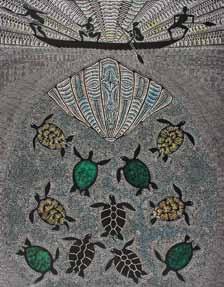
26 November 2011–4 May 2012
South Gallery and Tasman Gallery
t his November the museum commemorates 20 years since its opening. Celebrate with us and view this photographic exhibition: from royalty and rock stars to vessels and vikings, from behind the scenes to the big blockbuster shows, see some of the highlights from the past 20 years.
Museum Moments
photographic competition
Share your museum moments in our 20th anniversary photographic contest. Submit images past and present online or via post with a short byline and contact details. entrants will go on Flickr. great prizes including a digital Slr valued at $4,000 for best photo. information at www.anmm.gov.au/20years
AQUA – a journey into the world of water
Coming in December!
a multi-sensory experience for the whole family.
Created by ONe DrOp, an initiative of guy l aliberté, founder of Cirque du Soleil®
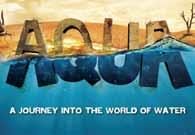
below left: m itchell Donaldson, 2004. a N mm Collection far left: Scott p olar r esearch nstitute centre: ( Sheltered Turtles Behind the Reef ), a N mm Collection left: a N mm photograph
Scott and polar party at South pole
mudhaw Warul by billy missi 2007
Design for Siev X memorial project
Sig N al S 96 September t O N O vember 2011 34
Destroyer Vampire drydocked July 2010



VOC jacht Duyfken 1606
inspect the replica of Duyfken (l ittle Dove), the Dutch e ast india Company ship that made the first recorded european visit to the australian continent, making landfall on the west coast of Cape York peninsula in april 1606. t he little scout ship or jacht was commanded by Willem Janszoon, who also made the first chart of mainland australia.
t he Duyfken replica was built in Western australia and launched in 1999, and has since re-enacted Janszoon’s original voyage of discovery. it is now on display at the museum while Endeavour is circumnavigating australia.
Duyfken replica tour included in the museum’s big ticket package (members F ree )


aNmm travelling exhibition
On their own –Britain’s child migrants
Until 24 September 2011 Migration Museum, South Australia
8 October 2011–6 May 2012 Immigration Museum, Museum Victoria From the 1860s until the 1970s, more than 100,000 british children were sent to australia, Canada and other Commonwealth countries through child migration schemes. Few were orphans; many came from families who were unable to care for them. the lives of these children changed dramatically and fortunes varied. Some succeeded in forging new futures; others suffered lonely, brutal childhoods. all experienced dislocation and separation from family and homeland.
a collaboration between the aNmm and National museums l iverpool, UK

Sail Away program
Freshwater Saltwater – Aboriginal and Torres Strait Islander prints
Until 7 August 2011
Tweed River Art Gallery NSW vivid representations of marine life and environments celebrate indigenous culture and the struggle of these communities for justice and land and sea rights.

Sons of Sindbad –the photographs of Alan Villiers 4 August–2 October 2011
Bribie Island Seaside Museum QLD allan villiers’ photographs of his voyages aboard arabian dhows in 1938–39 capture age-old indian Ocean sailing traditions, the skills of the sailors and pearl divers and the great hardships they endured, and what he thought were the ‘last days of sail’ in the red Sea, the persian gulf and the coasts of arabia and east africa.
in collaboration with the National maritime museum, greenwich, UK with the assistance of William Facey and grace pundyk

Wrecks, reefs and the Mermaid 9 November 2011–12 February 2012
National Wool Museum Geelong VIC photographs by Xanthe rivett illustrate the museum’s work during two archaeological expeditions to remote coral reefs off the coast of Queensland.
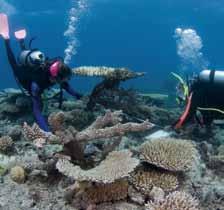
below right: r eproduced courtesy artist and b ukul arrnggay m ulka Centre right: Duyfken r eplica 1606 Foundation centre: r eproduced courtesy Sydney l ee far right: a llan v illiers photograph, courtesy of National m aritime m useum g reenwich UK below far right: photographer Xanthe r ivett 2009
Child migrant Stewart lee, 1955
exhibitions
visiting vessel Duyfken replica
baru (Crocodile) by Nancy gaymala Yunupingu 2005
Triumph of Righteousness 1938–39
Divers and the Mermaid anchor
Sig N al S 96 September t O N O vember 2011 35
For schools
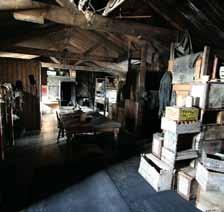
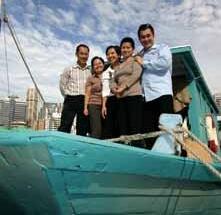
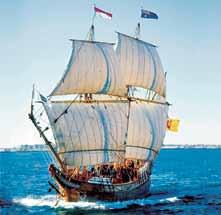
Scott’s last expedition
Years 4–12 HSIE, Science, Geography
Commemorating the centenary of Captain robert Falcon Scott’s tragic last expedition to antarctica (1910–1913), this extraordinary exhibition explores new perspectives on everyday life in the antarctic, scientific achievements, the harsh but amazing environment, and stories of human endeavour. Features original artefacts and scientific specimens plus a stylised representation of the Cape evans hut. perfect to combine with a viewing of Antarctica on the big screen at imax t heatre. (enjoy a $1 discount per student at both venues if you book both.)
Tour only $6 per student
Imax package $14 per student
Navigators
Years 3–10 HSIE
t he exhibition Navigators – defining Australia investigates early australian contact. Students encounter stories of non-european traders, examine traditional and scientific navigation techniques, and consider the influence of early european explorers. to complement this tour and gain an insight into pre-19th century life at sea, students can also board the restored 1874 bark James Craig
Navigators tour $6 per student
Navigators and Duyfken $12 per student
Transport
Years K–2 HSIE, Science
Students tour the museum identifying various forms of transport connected with water – sailing ships, rowboats, ferries, tugs, a Navy destroyer, a submarine and even a helicopter! an optional cruise by heritage ferry takes in industrial, commercial and passenger transport systems on the harbour. Guided tour (cruise extra) $6 per student
Immigration
Years 9–10 History, English
Designed for students learning about postWWii immigration, this hands-on program includes an introduction to immigration history, the study of a particular migrant group, and 1970s boat people. topics include child migration, Japanese war brides, and Tu Do, a vietnamese refugee boat that arrived in Darwin in 1977. Students rotate through all components in the museum and at our wharf.
Workshop and tour (2–2½ hour program) $12 per student
Maritime archaeology
Years 5–11 History, HSIE, Science e xplore the nature and practice of underwater archaeology and research the past through shipwreck stories. investigate the role of archaeologists, curators and conservators through a hands-on workshop and a tour of archaeological displays in the museum. programs for primary and secondary students; Senior maritime archaeology program relates to the NSW preliminary Course in Stage 6 ancient History. prices vary according to age group (please see website for details)
Shipwrecks, corrosion and conservation
Years 11–12 Chemistry
For the NSW Stage 6 Chemistry syllabus. program includes a multi-media presentation on metals conservation, an experimentbased workshop and a tour of shipwreckrelated material in the museum’s galleries. Students can also visit our Navy destroyer HmaS Vampire and submarine HmaS Onslow. Comprehensive notes are supplied. $20 per student (4 hours – minimum numbers apply)
Duyfken
Years 2–12 HSIE, History in 1606, the Dutch e ast india Company ship Duyfken made the first recorded european visit to the australian continent, landing on Cape York peninsula. Duyfken, meaning ‘l ittle Dove’, was commanded by Willem Janszoon, who also made the first chart of mainland australia. t he Duyfken replica was built in Western australia and launched in 1999, and has since re-enacted Janszoon’s original voyage of discovery. t his program is ideal to combine with a tour of our Navigators – defining Australia exhibition.
Ship only $8 per student
Ship and Navigators tour $12 per student
Pyrmont walk
Years 7–12 History, Geography l ed by a museum teacher-guide, students explore this inner-city suburb from the perspective of changing demographics, construction, planning and development. t his program is suitable as a site study for Stage 4 History and for Stages 5 and 6 g eography. a harbour cruise examining change and development along the waterfront is also available.
Guided tour Years 7–10 $12 per student
Years 11–12 per student $15 (cruise extra)
Over 30 programs are available across a range of syllabus areas for students K–12. Options include extension workshops, hands-on sessions, tours with museum teacher-guides and harbour cruises. See the Schools link on our website (www. anmm.gov.au) for details of all programs. Bookings essential phone 02 9298 3655 fax 02 9298 3660 or email bookings@anmm.gov.au
far left: ©New Zealand a ntarctic Heritage t rust 2009 centre: photographer a Frolows/ a N mm left: Courtesy
1606 r eplica Foundation
Scott’s base camp hut at Cape evans today
Duyfken
Tu Do at the museum’s wharf
Sig N al S 96 September t O N O vember 2011 36
the Duyfken replica

Lifejacket – wear it
Lifejackets save lives. But a lifejacket will not save your life if you are not wearing it. Remember:
• You must carry a lifejacket for every person on board
• Children under 12 must wear a lifejacket at most times
• Wear one at times of heightened risk such as crossing a coastal bar
• PWC drivers and passengers must wear them at all times
• Don’t just have lifejackets on board, make sure you and your passengers wear them.
For more information see our website or call the Info line.
Info line 13 12 56 www.maritime.nsw.gov.au MAR0270/UC 08/11
MAR0270_Lifejacket 128x178 ad_v1_FA.indd 1 21/07/11 11:27 AM Sig N al S 96 September t O N O vember 2011 37
Nmm greenwich update
New Sammy Ofer wing opens

Sig N al S 96 September t O N O vember 2011 38
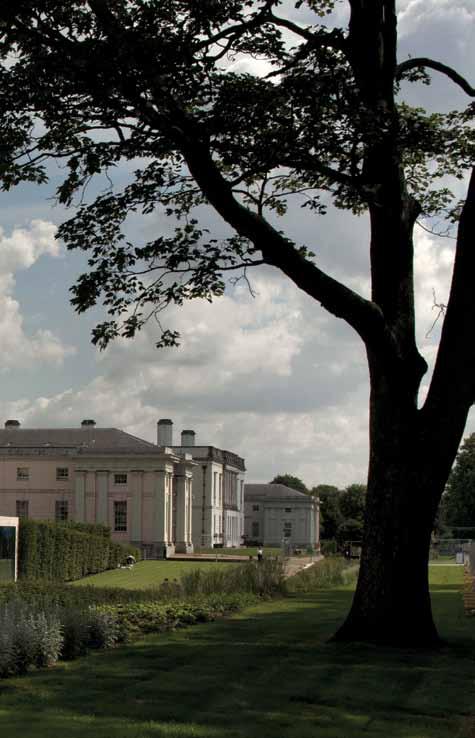
the exterior of the National maritime museum’s new Sammy Ofer Wing, viewed from the south west corner of the landscaping. all photographs reproduced courtesy of National maritime museum, london
We asked the aussie head of britain’s National maritime museum for an update on the renowned institution that’s housed in baroque heritage masterpieces on the prime meridian in london. Dr Kevin Fewster, once the australian National maritime museum’s founding director, writes from greenwich park on the thames
I sometimes wonder if my career has been in the culture or construction industry. When I sat down to write this article I quickly calculated that for 18 of the 27 years I’ve been a museum director I’ve led six major construction projects. Opening the Australian National Maritime Museum and, a decade later, building the Wharf 7 Maritime Heritage Centre are undoubtedly two standout highlights, as was creating the Powerhouse Museum’s Powerhouse Discovery Centre at Castle Hill in western Sydney. My latest challenge has proved equally exciting: building the new 7,300-square-metre Sammy Ofer Wing at the National Maritime Museum in Greenwich, England.
I arrived at Greenwich in September 2007, the first non-Brit to lead the world’s largest and most-visited maritime museum. Located in the glorious Maritime Greenwich World Heritage Site nine kilometres east of central London, the museum combines three public sites:
Sig N al S 96 September t O N O vember 2011 39
Old buildings are rarely suited for modern museum needs and World Heritage Site status carries with it considerable responsibility
the 1616 Inigo Jones-designed Queen’s House, Christopher Wren’s 1675 Royal Observatory (home to the world’s Prime Meridian and Greenwich Mean Time) and the maritime galleries housed in a complex of heritage-listed early 19th-century buildings. These unique attributes also bring their own problems; old buildings are rarely suited for modern museum needs and World Heritage Site status carries with it the considerable responsibility to respect and protect the buildings and their setting.
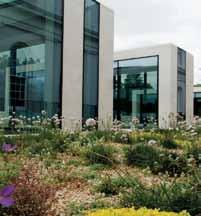
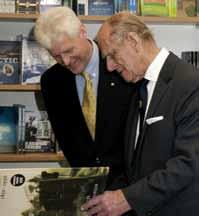
The National Maritime Museum at Greenwich possesses the world’s largest archive of material relating to maritime history but the library, opened in 1937, lacked the technology expected of a modern research facility. When I arrived as director, plans were well developed to relocate and upgrade these facilities, but I felt that we needed to be more ambitious – if we were to undertake a major new construction on-site we must gain the maximum benefit possible, especially given the constraints that our World Heritage Site location might impose on any future building development.
It was our great fortune that, no sooner had I arrived, the international shipping magnate Sammy Ofer pledged £20 million (A$30 m) to our project. Britain’s Heritage Lottery Fund granted us £5 million (A$7.6 m) and, miraculously, within the year we had assembled the entire £35.25 million (A$53.4 m) project funding. The urgency of our appeal was undoubtedly helped by the fact that the museum and adjacent Greenwich Royal Park will provide the venue for the equestrian and modern pentathlon events at the 2012 London Olympics and Paralympics, opening 12 months from now (late July) as I write. We were not slow in reminding potential funders and planning authorities that their help could ensure that our new facilities were open in time for the Games in 2012. As it happens, we’ve completed the new Sammy Ofer Wing 10 months ahead of program, at a final outturn cost of £36 million (including some exhibition works not factored into the original budget). Sadly, Sammy Ofer passed away, aged 89, some five weeks before the official opening.
consisted of two main elements: converting an 1820s building into the museum’s new library/archive and integrating it with a new building. The profile of the new extension has been kept low to allow the Victorian façade to be appreciated as a backdrop to the stunning new building. To achieve this, much of the construction has been placed underground. The external spaces sit over the new building and provide a threshold between the Baroque composition of Greenwich Park and the new building adjacent to the museum’s south-west wing.
In combination, these alterations create a seamless transition from the parkland, through the museum’s formally landscaped areas, to the crisply detailed new wing. The geometries of the hard and soft elements of the landscape extend out from the architectural gestures. A green swathe of Greenwich Park sweeps up to and fuses with the architectural composition. Ascending and descending planes of lawn draw people down to the entrance doors. Tight-clipped hornbeam hedges clothe ramps clad in Portland limestone that lead visitors up to the elevated podium.
Wherever possible, we adopted best-practice sustainability features. The heating and cooling plant, for example, utilises an aquifer thermal storage system whereby two 80-metredeep bore holes use the earth’s latent heat to moderate temperature fluctuations. This, and other initiatives, should reduce our CO2 emissions by over 20%.
Officially opened by the museum’s patron, HRH the Duke of Edinburgh, on 12 July 2011, the Sammy Ofer Wing is the catalyst for the organisation to change completely the way it presents its galleries, exhibitions and events.
the
the Compass lounge in the wing.
Children interacting with the ‘Wave’ in the National maritime
new Voyagers
the Wave in the new Voyagers
The Danish firm, C F Møller Architects, were responsible for the concept design of the wing and the English practice, Purcell Miller Tritton, were the executive architects. The principal building contractor was the Australian owned company, Bovis Lend Lease. The project
By refurbishing a heritage-listed 1820s building and integrating it with a simple, understated new building, the project creates an 820 m2 special exhibitions gallery, allowing the museum to stage a greatly expanded program of temporary shows; a permanent gallery, Voyagers, introducing the story of Britain and the sea; a fine-dining brasserie and café with views over Greenwich Park; expanded retail facilities; and a state-of-the-art library and archive bringing much of the museum’s world-renowned archive on site for the first time.
The building gives the museum a new main entrance from Greenwich Park, enhancing its connections with the park, the Royal Observatory, and the rest of the Maritime Greenwich World Heritage Site.
clockwise from above:
Dr Kevin Fewster, Director of the National maritime museum, and His royal Highness the Duke of edinburgh at the opening of the museum Sammy Ofer Wing on 12 July 2011.
light wells of the National maritime museum’s new wing.
Sig N al S 96 September t O N O vember 2011 40
museum’s
gallery.
gallery.



Sig N al S 96 September t O N O vember 2011 41
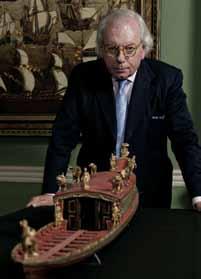
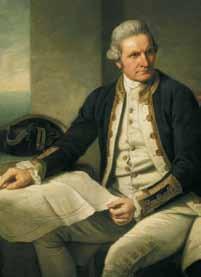
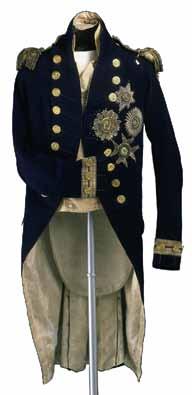
The new wing gives the museum an opportunity to focus on the stories of adventure, discovery, tragedy, courage and disaster that make it distinctive, leaving visitors with a richer understanding of Britain’s maritime heritage. Symbolic of this new approach, the Sammy Ofer Wing’s Voyagers gallery acts as an introduction to the extraordinary depth and range of the museum’s collections. It showcases over 200 objects, many of which have never been on display before, alongside cuttingedge audio-visual installations.
A 30-metre-long object wall tells stories of Britain and the sea from the 16th century to the 20th. Sir Francis Drake’s sun jewel sits alongside Cook’s sextant; the 200-year-old love token of an engraved ship’s biscuit is displayed beside Nelson’s last letter to his daughter; and an Astronomer Royal’s orrery takes its place with a passenger’s lucky toy pig that survived the sinking of RMS Titanic
Illustrating the contemporary significance of Britain’s maritime histories and highlighting key themes from across the museum, Voyagers is dominated by a dynamic, wave-like structure featuring bespoke digitised-image projections and a specially designed soundscape. Intensely coloured patterns of images and text wash over its 20-metre-long multifaceted surface, creating a constant sense of movement that draws you down the gallery to an end-wall awash with notable quotes illustrating the place of the sea and matters maritime in English literature.
Different elements of the Sammy Ofer Wing interact to create new connections, and the collections displayed in Voyagers lead visitors towards the rehoused, modernised Caird Library where they can unlock the rich treasures of the museum and discover the stories behind the great events of the maritime past. Among the myriad of iconic material within the archive and library collections are one of James Cook’s handwritten journals from his Endeavour voyage; the log book of Robert Maynard, the man who killed Blackbeard; Shackleton’s personal copy of Browning’s poems, carried by him to the Arctic; and the log book of the slave ship captain, John Newton – writer of Amazing Grace
The museum holds perhaps the world’s most important maritime archive, containing 100,000 books and over three kilometres of shelved manuscripts. When the full archive is available later this year, professional researchers, students, community groups and those exploring their family history will have
unprecedented access to a vast range of journals, letters, records, charts, prints and drawings as the new wing enables key archives to be stored in best-practice conditions on the Greenwich site for the first time.
General visitors will be able to sample the museum’s collections and archive treasures through the Compass Lounge, a casual drop-in area adjacent to the new foyer providing the latest digital technology to facilitate accessible archive experiences. The visitor can take their experience still further with their own Digital Compass card. Stamping the barcoded card in special readers near selected artefacts around the galleries loads up additional materials that can later be downloaded either in the Compass Lounge or taken home and accessed at one’s own computer. So, for example, if you ‘collect’ Nelson’s Trafalgar uniform, you discover the journal of George Perceval, an 11-yearold boy who was also at the Battle of Trafalgar, or the letters of Nelson’s mistress, Emma Hamilton.
The new wing is the first step in the museum’s plan to create a more coherent narrative for visitors that will enhance their understanding and enjoyment of the organisation’s unique cluster of historic venues. In coming years a series of redeveloped permanent galleries will refresh the museum’s key themes, appealing to a wider and more diverse audience, complemented by a schedule of major charging exhibitions and supported by an integrated learning and events program.
The first of these new permanent exhibitions, Traders: the East India Company and Asia, opens this September. Drawing on the museum’s great collection riches in these areas, Traders explores the history and continuing relevance of Britain’s trade with Asia and the subcontinent, looking at this complex story through the lens of the East India Company and the commodities it traded. Looking ahead over the next few years the museum will open two new Royal Navy galleries, a revamped Maritime London gallery, an Exploration gallery (focusing largely on James Cook), a new children’s gallery and an exhibition addressing issues of the marine environment and climate change.
Environmental issues are also the focus of the first exhibition in our new special exhibitions gallery. Running until January 2012, High Arctic seeks to convey the scale, beauty and fragility of our unique Arctic environment through
Sig N al S 96 September t O N O vember 2011 42
Fans of The King’s Speech might like to know that NMM’s 1937 opening was the second speech George VI delivered as King
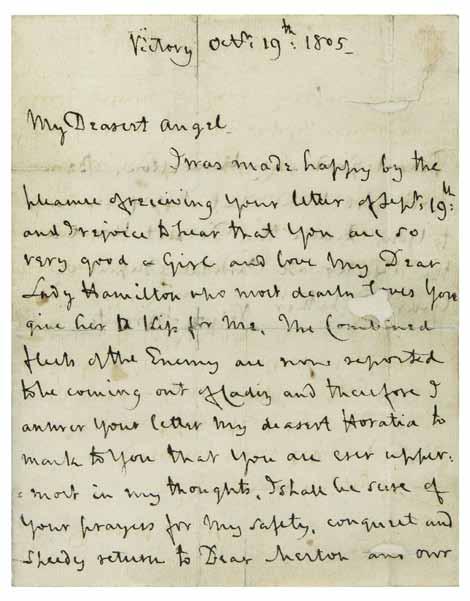
an absorbing installation that encourages us to question our relationship with the world around us. The exhibition contains no objects, no touchscreens, no photographs or video, and no text panels. Instead, High Arctic is a genuinely immersive, responsive environment, developed in conjunction with the award winning London-based art and design practice, United Visual Artists, and the environmental foundation, Cape Farewell. The object-free High Arctic installation will be followed in April 2012 by a true blockbuster, Royal River – power, pageantry and the Thames, showcasing more than 350 magnificent objects drawn from our own collections plus loans from The Royal Collection, and over 60 other major museums and private collections to mark the Queen’s Diamond Jubilee and London’s Olympic year.
April 2012 will mark the 75th anniversary of the opening of the National Maritime Museum by King George VI (fans of the recent Geoffrey
Rush and Colin Firth movie The King’s Speech might like to know that our opening was the second speech he delivered as King). The new Sammy Ofer Wing is the largest post-opening development in the National Maritime Museum’s 75-year history. The wing creates a spectacular contemporary environment in which more people can appreciate the wonders of the museum’s world-class collections and their stories of human endeavour and discovery.
The opening of this new wing is only the start of a program to revitalise and refresh our permanent galleries and exhibitions. Through this, we will be able to transform the experience we offer to the two million visitors from Britain and overseas who visit us each year. This will help to ensure that current and future generations from all over the world understand the rich and complex story of the British Isles and the crucial role played by the sea in the history and the lives of those who depended upon it.
Dr Kevin Fewster am was an academic historian prior to his first museum posting, to redevelop and launch the South australian maritime museum. From 1988 to 2000 he was founding director of the australian National maritime museum, leading it to its opening in 1991 and developing the museum’s $20 million Wharf 7 maritime Heritage Centre, opened in 1999. Kevin was director of Sydney’s renowned powerhouse museum from 2000 to 2007 when he took the helm at the National maritime museum, greenwich UK.
clockwise from above:
the last letter to Horatia Nelson from her father Horatio Nelson.
the undress uniform coat worn by Nelson at trafalgar. the fatal bullet hole is visible in the left shoulder.
Captain James Cook, 1728–79, by Nathaniel Dance, 1775/76. greenwich Hospital Collection
guest curator David Starkey views a model of a ceremonial barge (c.1780) to be displayed in the National maritime museum’s 2012 exhibition, Royal River: Power, Pageantry and the Thames
Sig N al S 96 September t O N O vember 2011 43
australian register of Historic vessels
H istoric
From kayaks to cruisers to coastal ketches
another 18 craft were approved for listing on the australian register of Historic vessels when the arHv Council met in July 2011. among the diverse selection are two cruising yachts that highlight the way in which australians have realised their ambitions to build a yacht and explore the oceans, says arHv curator David Payne.
cruising the world has been a dream for many Australians, and some have only been able to turn that dream into reality by building their own yacht. Owner Harry Newton Scott designed New Silver Gull, then built it on the shores of Yowie Bay, Sydney, in 1939. In 1945 he started cruising with his wife Oceana, first to Hobart, then to New Zealand and finally out into the Pacific. With its unusual but easily handled wishbone rig, New Silver Gull eventually reached Nova Scotia before returning home in 1959 after covering 43,000 nautical miles.
Early in the 1960s teenager Andy Wall had the same desire to sail the oceans, so in 1964 he fitted out and then launched his own small Carmen class yacht Carronade. He then set off with an equally youthful crew to cross the Pacific before turning south. After a dramatic knockdown and roll, they rounded Cape Horn in March 1967, shortly after the celebrated passage made by Sir Francis Chichester. Later Andy, his wife Pam and young family cruised Carronade until a bigger yacht was needed. Subsequent owners of both Carronade and New Silver Gull have respected the yachts’ histories, and both remain in excellent condition.
The MOBI Yacht Nirimba has sailed extensively along Australia’s coastline, competing in many Sydney to Hobart
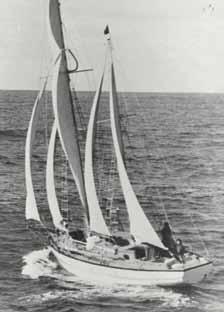


yacht races. Built by Royal Australian Navy apprentices at their Quakers Hill training school HMAS Nirimba between 1962 and 1966, the steel sloop designed by Alan Payne became a sail training yacht for the Navy, before going into private ownership. Recently, a group of ex-RAN apprentices who had built the boat formed a syndicate and bought it back.
Falie is large sailing ketch that has navigated Australia’s coastline as a commercial vessel. Although fitted with an auxiliary engine, it has traded under sail as its primary source of power, and after sailing out from Holland where it was built in the early 1920s, it spent most of its life operating in South Australian waters.
Ajax and Sea Rover are contrasting types of sailing dinghies. Ajax is a classic 12-Foot skiff with a long history in the class, including winning the national championship and representing NSW in the early Interdominion series. Sea Rover shows the influences that came from outside Australia. It is a Germandesigned Heavyweight Sharpie, a class of sailing dinghy that became well established in Australia. The class achieved one of Australia’s first Olympic sailing medals, Roly Tasker’s silver in 1956. In the 1960s a typically Australian version of the class developed, the plywood, lightweight Sharpie that superseded the heavyweights. Sea Rover now sails occasionally at regattas to show the youngsters the origins of their class.
02-14 Action saw service in World War II, operating as an air-sea rescue craft for the RAAF. After decommissioning it became a yacht club launch on Port Phillip, but now serves as a dive boat supporting amateur divers searching for wrecks in deeper waters off the Victorian coastline. Kowarra and Bunda-La had more sedate service roles. Kowarra was built in 1945 as a tow boat, and later spent decades as a tug in South Australia. Bunda-La was the pilot vessel at Port Hinchinbrook and other ports on the Queensland coast.
Florinda and Little Nipper are both great examples of the once-prolific clinker motor launch, those little open boats with small petrol engines that ‘putt-putted’ around waterways everywhere. Florinda was part of the H C Press family’s many boatshed operations, as well as supporting
top to bottom:
Cruising yachts, the wishbone ketch
New Silver Gull and the australian production Carmen sloop Carronade photographs courtesy of current owners.
South australian trading ketch Falie
Sig N al S 96 September t O N O vember 2011 44
www.anmm.gov.au/arhv this online national heritage project devised and coordinated by the australian National maritime museum reaches across australia to collate data about the nation’s extant historic vessels, their designers, builders and their stories.
their 18-Foot skiffs on the summer weekends. Little Nipper was a Shevill Brothers craft, and spent much of its active life as a recreational fishing boat, trailed to where the fish were biting.
More of the famous Halvorsen fleet have been accepted into the register.
Aoma, a Standard 30-foot motor cruiser that moved between private ownership and the Halvorsen hire-boat fleet, is now one of the many standout restorations of these popular craft. Meanwhile Kalinda flies the flag for the small number of larger luxury Halvorsens that were exported to the USA in the early 1950s. It had a colourful life on the west coast where it was much admired, before returning home for a recent restoration.
Speed on two levels is the shared theme for Kerrie Ann and The Sting Kerrie Ann is believed to have started out as Skylark in the late 1950s, a Sports Craft family skiboat that also won its class in the famous Hawkesbury River Bridge to Bridge race. The Sting, however, would leave Kerrie Ann trailing in its wake. A rare operational example of a wooden Unlimited Class three-point hydroplane that still holds records in South Australia, you can see and hear this veteran running at over 100 miles per hour (160 km/h) at the biennial Goolwa Wooden Boat Festival.
The K2 Olympic kayak represented Australia in 1960 at the Rome Olympics. Dennis Green and Wally Brown took part in the 10,000 metre event; their craft, built in Denmark by the outstanding builder K S Struer, was planked in a single, steamed sheet of Australian cedar.
Cedar was used to plank the two rowing craft registered in July. The Gladstone skiff was built by former world sculling champion George Towns and used for training at the Sydney King’s School boatshed. The rowing eight Toyota was built of thin cedar veneer in Sydney by Sargent and Burton. It won the nation’s premier rowing event, the King’s Cup, for South Australia three times in succession from 1981 to 1983, 44 years after the state’s last win. Four members of the crew formed the basis of Australia’s bronze medal-winning eight crews in the 1982 world championships and the 1984 Munich Olympic Games. At their reunion in 2011, the South Australian crew once again rowed Toyota as a team.
02-14 Action
1942 HV000453
builder Spring & Dinard
type air-sea rescue launch
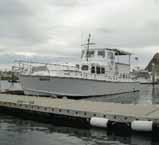
1950 HV000449
builder l es and Don barnett
type 12-Foot skiff
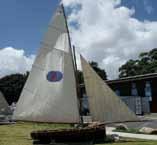
1963 HV000455
builder l ars Halvorsen Sons
type motor cruiser
Bunda-La
1958 HV000464
builder Queensland Department of Harbours and marine type pilot launch
Carronade
1964 HV000454
builder Swanson bros
type Cruising yacht
Falie
1920 HV000459
builder W richter Ultdenbogaardt
type trading ketch

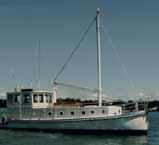
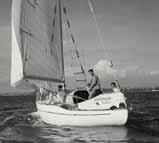
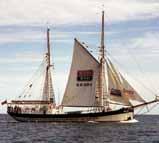 Ajax
Aoma
Ajax
Aoma
all photographs are reproduced courtesy of the vessel owner Sig N al S 96 September t O N O vember 2011 45
Florinda
1949 HV000466
builder H C press
type motor launch
Gladstone rowing skiff
c1940s HV000465
builder george towns & Sons
type rowing skiff
K2 Olympic kayak 1960 HV000467
builder K S Struer
type Olympic racing kayak
Kalinda 1950 HV000463
builder l ars Halvorsen Sons
type bridge-deck motor-cruiser
Kerrie Ann
c1950s HV000458
builder Sports Craft
type Speedboat
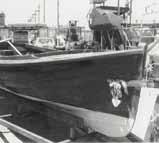
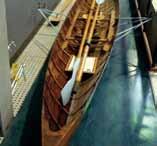
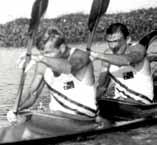


Little Nipper
c1930s HV000468
builder N & W Shevill
type motor launch
New Silver Gull
builder Harry Newton Scott
type Cruising yacht
Sea Rover
builder Colin roberts
type Sharpie sailing dinghy
The MOBI Yacht Nirimba
builder royal australian Navy apprentice training e stablishment
type racing yacht
The Sting
builder Newcombe and traeger

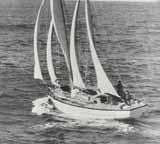
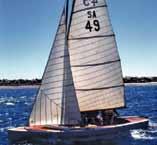


builder Unknown type
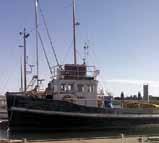
builder Sargent and burton type

1940 HV000339
1947 HV000457
1966 HV000456
1972
HV000460
Toyota 1979 HV000461
type t hree-point hydroplane
racing
shell
1945 HV000462
Kowarra
all photographs are reproduced courtesy of the vessel owner
Historic vessels Sig N al S 96 September t O N O vember 2011 46
tug and towboat
australian register of
arHv on the world stage

e arly in july, arHv curator David Payne attended the inaugural meeting of the international Historic and traditional Ships panel of the international Congress of maritime museums (iCmm), held in the Netherlands and hosted by the rotterdam maritime museum and its director and current iCmm president, Frits loomeijer. the panel was chaired by arHv steering committee and council member alan edenborough, from our sister organisation Sydney Heritage Fleet.
The International Historic and Traditional Ships panel has major longterm ambitions based around its broad objective of being an advocate for historic and traditional ships at an international level. This includes operational or static historic craft, replicas and new craft built or rigged along traditional lines.
The Australian National Maritime Museum is one of very few institutions that have vessels fitting almost all the major categories: the replica HM Bark Endeavour, an operational tall ship
in commercial survey; three large staticdisplay vessels in our submarine Onslow, destroyer Vampire and light ship CLS4 Carpentaria (and smaller craft in our galleries and collection); plus the fleet of operating historic vessels in the collection: yachts Akarana and Kathleen Gillett, refugee boat Tu Do, RAN patrol boat Advance, pearling lugger John Louis and ’couta fishing boat Thistle. The museum is thus closely involved in the whole range of issues addressed by the International Historic and Traditional Ships panel. These include questions of historic interpretation, conservation, restoration and many other aspects of vessel management. One example is the conflicts that can arise through the need for survey or certification under rules or authorities better suited to regulating contemporary rather than historic vessels.
This meeting brought together for the first time museum and private owners of historic and traditional craft from Europe, the USA and Australia, and consensus was reached over the two days on the need for a coordinated international voice, coming through ICMM. The panel enthusiastically divided itself into subgroups to begin the groundwork needed to establish foundations. Using the internet for electronic meetings over
the next nine months, the panel plans to meet again in Bristol, UK, in March 2012 to prepare the next step forward.
The Rotterdam Maritime Museum is well over 100 years old, with a remarkable collection of centuries-old material housed in a modern building adjacent to the water with many historic Dutch craft moored nearby. Rotterdam provided an excellent setting for the meeting. The city is a major river and ocean port for Europe and there was constant commercial activity on the water. Moored close to the city centre are many registered historic barges, tugs and other working craft that can use a historic shipyard with a slipway and a working crane, while around this working harbour are cafes and apartments. It is eye-opening to see both the range of vessels and the tolerance by the community of all this industrial maritime activity within a residential zone. It also underlines how many historic craft exist and will need support and recognition for their longterm survival.
above: members of the international Historic and traditional Ships panel at rotterdam.
arHv curator David payne and council member alan edenborough, back row 3rd and 4th from left.
register of
australian
Historic vessels
Sig N al S 96 September t O N O vember 2011 47
Welcome
a ghost Story
the intriguingly named bathsheba ghost overcame the stain of a convict past to become one of the most prominent – and best-paid –women workers in the mid19th-century colony of New South Wales, writes Veronica Kooyman Her descendants in australia have added her name to the Welcome Wall, to be unveiled on 18 September this year.
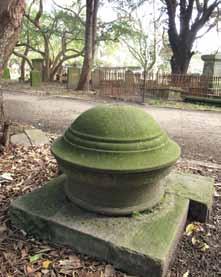
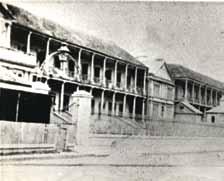
on 19 may 1838 at the Central Criminal Court of the Old Bailey in London, Bathsheba Ghost was found guilty of receiving stolen property and was sentenced to 14 years transportation to the colony of New South Wales. Arriving towards the end of the convict era, she rose to one of the most prominent and well-paid positions a female could hold in the colony: she was Matron of Sydney Infirmary and Dispensary for 14 years.
Christened into the Church of England on 25 December 1809 at Ashcott in Somerset, England, Bathsheba Dominey was the eldest of six children. In 1838, aged about 29, she lived at 338 Oxford Street, London, with her husband Thomas Ghost and their three-year-old son Thomas, and had been working as a ladies nursery maid. Transportation records describe her as ‘five feet two inches [1.52 metres] tall, sallow freckled complexion with light brown hair, grey eyes and can read and write’. At the same trial a young neighbour, Michael Woolf, was found guilty of stealing a necklace, two lockets, a seal, seven rings, four slides, two clasps and a pair of snuffers from his own mother and stepfather. Only 17, he was recommended for mercy and sentenced to seven years transportation.
Trial records relate that Michael had been estranged from his newly remarried mother Eve Jacobson, also of Oxford Street, for some time. Attempting to reconcile the two, Bathsheba took him to see his mother and stepfather and advised Eve that her son lived in distress and poverty. A fortnight after the reconciliation Michael visited the Ghost residence; the Jacobsons discovered that there were items missing from their residence and called the police. Constable Henry Sherwin from the Marlborough Street station searched the Ghost premises with Mr Jacobson present and found a coral necklace apparently belonging to Eve Jacobson. He also perceived that Bathsheba was attempting to conceal yet more jewellery beneath her apron. Mr Ghost distanced himself from the crime, publicly upbraiding her for having such items on the property, though he himself worked for a jeweller and some

of the stones had been removed. Despite several good character witnesses Bathsheba was found guilty.
This period of transportation was marked by the use of older vessels that had been surveyed as seaworthy but were in poorer condition, since faster and newer private vessels were busily employed in the more profitable trade of transporting migrants to America. Notwithstanding discontent among convicts and sailors, mutinies rarely occurred, although the practice of prostitution on board the female transports was a constant problem. Despite this, there were fewer deaths from disease during the passage in the late 1830s and exceptionally few reports of serious abuses towards prisoners. After four months at sea, Bathsheba Ghost arrived at Port Jackson in March 1839 aboard the Planter with 170 other female convicts. Thus began her solitary exile, separated from both child and husband, deprived of motherhood itself.
Six years after her arrival in the colony, while working as a domestic servant at a property in Sydney’s Castlereagh Street, Bathsheba was given her ticket of leave. This allowed her to work as a free woman so long as she remained in the district of Sydney. It is thought that soon afterwards she began working as a nurse at the Sydney Infirmary and Dispensary. Two years later, in 1847, she was granted a conditional pardon and was free so long as she did not return to Britain. Sydney Infirmary and Dispensary, today known as Sydney Hospital, was a prominent public institution at the time claiming its origins in the first sick tents pitched on the west side of Sydney Cove when the First Fleet arrived. Tents and temporary buildings remained until 1811 when Governor Macquarie moved the infirmary to the present Macquarie Street location. The one he built there was known as the Rum Hospital after a deal with the building consortium rewarded them with a monopoly on importing rum into the colony.
In 1852 Bathsheba became the Matron of the Sydney Infirmary and Dispensary with an initial annual salary of £80, board and lodging provided. By 1854 this salary
tales from the wall
Sig N al S 96 September t O N O vember 2011 48
the museum’s tribute to migrants, the Welcome Wall, encourages people to recall and record their stories of coming to live in australia
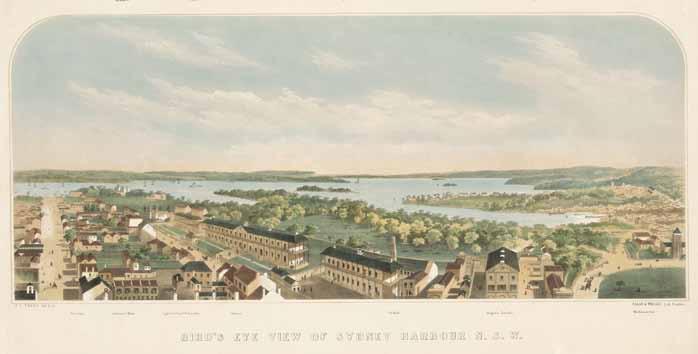
was increased to £100, and finally £120, one of the highest salaries for a female in New South Wales. Her responsibilities included maintaining an accurate inventory of all household goods and provisions, including the utensils and incoming provisions; daily ward visits to check their cleanliness; ensuring the correct dietary provisions for each patient; checking the performance of nurses and servants; and maintaining the rules and behaviour of the patients and staff. She was also keeper of the keys, locking and unlocking the doors at the correct times. The hospital’s annual reports regularly praised her exertions in maintaining order and cleanliness, and for taking a leading role in training nurses under her care. Bathsheba worked during a period of significant change in medical practices – including the first use of anaesthetics. Bathsheba died in August 1866 of a lingering and painful disease of the uterus, relieved only by significant doses of drugs such as opium and alcohol. Maintaining her duties as Matron in the last few months of her life would have been extremely difficult. In her will Bathsheba bequeathed £100 to the
hospital, a significant sum in 1866. By the time of her death the hospital held 190 beds and was set to expand further. The infrastructure of the hospital buildings had been inadequate for some time, with crude sanitary arrangements and vermin living in the crevices of the walls.
Bathsheba never remarried, and we don’t know what happened to the husband who threw her to the wolves.
Towards the end of her life, however, her son Thomas migrated to Australia and she came to know her granddaughter Eliza. Other family members migrated voluntarily. Her brother Thomas, his wife Lydia and their two sons arrived in Victoria under the Bounty System in 1843. She also sponsored her brother Solomon and his wife Harriet, her sister Bethia and husband John Fry and the two couples’ nine children as free settlers. They arrived just months before her death, some of them working and boarding at the hospital. Fittingly Bathsheba died at her workplace, the place of her reputable reemergence into society. In 1953 the then Matron Elsie Pidgeon unveiled a memorial stone, taken from the present hospital, in St Stephens Cemetery Newtown in honour of Bathsheba.
above: the Sydney bathsheba knew at the end of her working life, showing macquarie Street with Sydney infirmary and Dispensary and Hyde park barracks. Bird’s eye view of Sydney Harbour, Frederick Charles terry, hand-coloured lithograph 1860s. Collection of National library of australia left top to bottom:
memorial to bathsheba ghost now in St Stephen’s church, Newtown; engraved on a capstone taken from Sydney Hospital. photographer J mellefont/aNmm
the original ‘rum Hospital’ in which bathsheba worked, prior to its demolition in 1878. Collection of lucy Osburn-Nightingale Foundation museum, Sydney
The Welcome Wall
It costs just $105 to register a name and honour your family’s arrival in this great country! We’d love to add your family’s name to The Welcome Wall, cast in bronze, and place your story on the online database at www.anmm.gov.au/ww. So please don’t hesitate to call our staff during business hours with any enquiries on 02 9298 3777.
Sig N al S 96 September t O N O vember 2011 49
Collections around the world with Janet Stevenson

a treasured scrapbook of memories from the around-the-world adventure of a young australian woman during the late 1950s has been generously donated to the museum, writes curator of post-Federation immigration Kim Tao.
A gift just to remind you
That though you travel far
We’ll meet again in England Till then, it’s au revoir
25-year old Australian Janet Stevenson received this farewell message just before embarking on a working holiday to Britain, Europe and North America in 1957. During her three-year sojourn, Janet collected an evocative array of shipping souvenirs, photographs, postcards and tickets, which she carefully
pasted into a scrapbook upon her return to Australia. More than 50 years after that life-changing voyage, Janet has donated this cherished memento to the Australian National Maritime Museum.
Aptly titled Around the world with Janet Stevenson, the scrapbook provides a delightful record of Janet’s adventures abroad. It also presents a perspective on outward-bound voyages from Australia – at a time when thousands of British and European migrants were arriving in Australia through postwar assisted passage schemes.
Sig N al S 96 September t O N O vember 2011 50

In this age of transient emails, electronic tickets and digital photographs, many travellers would find it difficult to compile such a souvenir. This makes Janet’s scrapbook all the more valuable – it is a tangible document of memory and a rich historical resource. Within its pages we follow Janet’s transformation from fresh-faced Sydneysider to worldly young woman.
In the 1950s and ’60s, the voyage to Britain by ocean liner was a traditional rite of passage for thousands of young Australians seeking further study,

career opportunities and adventure. After completing her high school Leaving Certificate, Janet spent a year at secretarial college before taking a job as a shorthand typist at book publisher Angus & Robertson. For the next six years she put away £5 per week to save for her trip.
In May 1957 Janet departed Sydney on the P&O liner SS Strathnaver, sailing around the Cape of Good Hope as the Suez Crisis had only recently been resolved and the shorter route through the Red Sea and Suez Canal had not yet been resumed. Janet travelled alone,
but quickly made friends on board with other young Australians and New Zealanders, with whom she would explore Britain and Europe.
‘That’s one good thing about going by ship,’ she recalls. ‘You’re sharing a six-berth cabin for five weeks. You had companionship. Nowadays you wouldn’t have time to make friends on a plane. Shipboard life was a bit boring in some ways – you would think of the next port and what you’d have for dinner. But I’d much rather ship travel – you can sleep in as long as you like!’
Collections
Around the world with Janet Stevenson. Open spread: Strathnaver shipboard newspaper, race card, port of call booklet, South africa, Canary islands. aNmm Collection
Sig N al S 96 September t O N O vember 2011 51
Collections
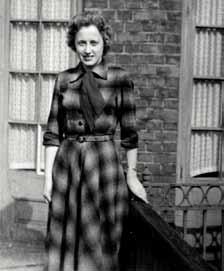
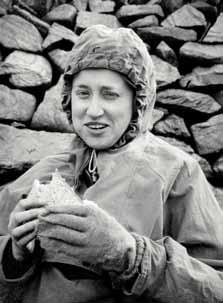

In the 1950s and ’60s, the voyage to Britain by ocean liner was a traditional rite of passage for thousands of young Australians
Her most memorable experiences were hitchhiking through Europe and climbing to the crater of Mount Vesuvius near Naples. Janet collected postcards, maps, and theatre and transport tickets from places that remain iconic sights and destinations for tourists today. They are displayed in her scrapbook alongside dried alpine flowers from Austria and still-vivid red and gold maple leaves from her later visit to Canada.
Janet acquired a range of ship menus, race cards, entertainment programs and portsof-call booklets, which she cherished as mementos of her long sea voyage. Bearing the distinctive P&O corporate identity, they constitute wonderful examples of postwar design. They also offer an insight into 20th-century shipboard life and evoke an era when the journey was just as important as the destination.
In London Janet shared a flat with some nurses and found temporary work as a shorthand typist. A series of letterheads in her scrapbook attests to the companies she worked for, including the London office of her Australian employer Angus & Robertson. Janet remembers, ‘The good thing about being Australian was they didn’t know how to classify you socially so you got the benefit of the doubt. There was class consciousness but they didn’t know where to put me so I got on well with everybody.’
While today’s travellers can easily remain in contact through email, mobile phones and instant messages, Janet was completely isolated from home and her loved ones on the other side of the world. The absence of communication in Janet’s scrapbook, apart from bon voyage telegrams and welcome-home cards, reinforces the physical and emotional distance that once separated travellers. Janet treasured any news about Australia, keeping clippings about Australian child actor Colin Petersen’s visit to Edinburgh in 1957 and the international rugby match between England and Australia at Twickenham in 1958.
From her base in England Janet went on to explore the Continent, echoing the classical Grand Tour with trips to France, Spain, Italy, Austria and Germany.
Janet sailed from Britain to Montreal, Canada, on SS Ryndam in June 1960, having decided it was time to head home. She had initially planned to travel for 18 months but had already been away for three years. From Montreal Janet toured through eastern Canada and the United States with a Greyhound bus pass, visiting diverse cities such as Quebec, New York, Chicago, Detroit and San Francisco. ‘It was great in America,’ recalls Janet. ‘You told them you were from Australia and they’d look at you like you’d come from Mars. They hardly knew where it was.’
In October 1960 Janet embarked from San Francisco on SS Iberia, which made port calls in Japan, Hong Kong and the Philippines before docking in Sydney. Reflecting on her epic voyage around the world, Janet says: ‘It made me more thoughtful of other people and other countries. But it also made me grateful for being Australian. It made me appreciate Australia more having left for awhile, especially the lack of class consciousness.’
After returning home Janet married Gordon Robinson and they raised three children in Sydney. Both Janet and Gordon volunteered at this museum for many years. During a recent visit to view her scrapbook, Janet remarked: ‘It does take me back. It’s quite nostalgic. Some things I had completely forgotten. I had slides but I’m glad I have the scrapbook because the slides have faded to nothing. It’s nice to think it’s got a home.’
top to bottom:
Janet Stevenson outside Strato publications, london, 1958.
Janet Stevenson shelters behind a dry stone sheep wall below tryfan mountain, Snowdonia, Wales, 1959.
Janet robinson (née Stevenson) views her scrapbook in a collections storage area at the museum, 2011. photographer a Frolows/aNmm
Sig N al S 96 September t O N O vember 2011 52

300 1 EXTRAORDINARY PEOPLE GOLD MEDAL CLUB MEMBERSHIP
The Perth 2011 ISAF Sailing World Championships are coming to Western Australia. Experience this Olympic Qualifying Event in style and become a Perth2011 Gold Medal Club Member today.

Join Gold Medal Club Ambassadors Elise Rechichi and Tessa Parkinson, the Women’s 470 Gold Medalists at the Beijing 2008 Olympic Games on the journey to the World Championships. Your membership includes:
• Your own seat in the Gold Medal VIP lounge, located on Bathers Bay (Centre Course).
• Mingle with Olympians, competitors, coaches and officials in this VIP area.
• A Leeuwin Estate Wine Tasting Function.
• Enjoy a special luncheon with the golden girls.
• A beautiful Membership package including the limited edition, award-winning Event book, a stunning white gold necklace and fashionable Perth 2011 cufflinks.
• Bonus offers from Perth 2011 sponsors, Kailis Jewellery, Holden and Little Creatures and many more.
• Includes a guest pass.
You can purchase this fantastic membership for only $990. Purchase online @ PERTH2011.COM or call (08) 9335 2688.








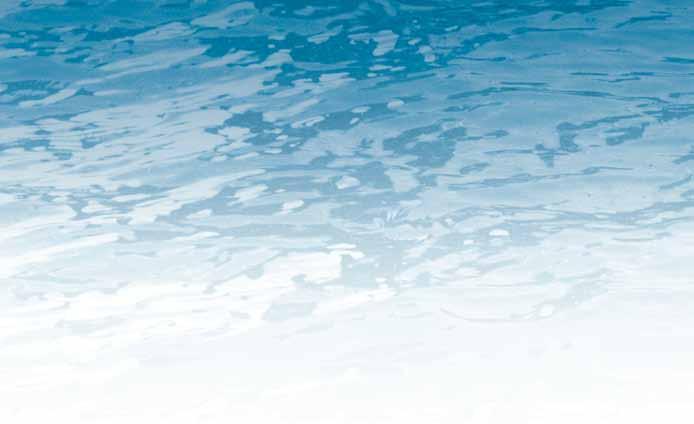

DMS Maritime Pty Limited Level 6, 210 Clarence Street, Sydney NSW 2000 Email: dmsinfo@dmsmaritime.com Telephone: 02 8001 1600 Facsimile: 02 8231 0172 www.dmsmaritime.com • Fleet operations and
• Fleet maintenance and management • Vessel and port services • Integrated logistics management • Marine systems support • Vessel build and modification • Maritime project management • Maritime training Total Asset Management: Skills, commitment + service delivery
2011
management
3-18DEC2011 PERTH
ISAF SAILING WORLD CHAMPIONSHIPS
THE DREAM
IN PERTH!
BEGINS
worlds@perth2011.com W PERTH2011.COM Sig N al S 96 September t O N O vember 2011 53
P +61 8 9335 2688 E
Currents busy week for museum mmapSS intern


Roger Cooper is honorary curator at the Holbrook Submarine museum in the southern NSW country town that abandoned its former name g ermanton during World War 1 and renamed itself after lt Norman Holbrook, hero of a british submarine raid on the Dardanelles. t he town’s celebration of submarines and submariners culminated in the ‘planting’ of the raN Oberon class submarine Otway, decommissioned during the 1990s, in a park beside the Hume Highway. roger, a former submariner who served in Otway and now manages the museum that interprets this arresting civic monument, recounts his week as an intern with the maritime museums of australia project Support Scheme (mmapSS).
i began my internship at the Australian National Maritime Museum with staff MMAPSS coordinator Clare Power, who worked hard to make my internship run well. Touring the museum’s galleries on my orientation tour, my camera worked overtime – collecting ideas and ways of showing artefacts to their best advantage. Then the staff of the Vaughan Evans Library gave me an overview of the wonderful services they provide, pointing me to the shelves that held everything I needed, and soon I was busy doing research on the submarine HMAS AE2 for a display at the Holbrook Submarine Museum.
Fleet Services manager Phil McKendrick had served in the Royal Australian Navy at about the same time as me and took me on board the small Vietnamese refugee boat Tu Do (‘Freedom’) in which the very brave Lu family placed their trust, reaching Australia in 1977. We set off down the harbour and circled Cockatoo Island, where I had spent six months during a refit of my submarine HMAS Otway in the early 1970s. We were located in the convict-built Sutherland drydock and in those days were awakened to the chug-chug of the steam-driven crane that circumnavigated the stone dock.
Peter Wood, who organises hundreds of volunteers, introduced me to the day’s contingent. The room buzzed when, responding to a question, I explained that we have just 10 at Holbrook. I met volunteer Catherine who was learning about the ANMM’s Oberon class submarine Onslow, which will be her next placement. I was asked to take her from the fore-ends to the after-ends explaining all the interesting bits and pieces, and how we used them in the daily routine of an ‘O’ boat. I also met and lunched with volunteer John Dikkenberg, an ex-Onslow captain and former Commander of the Australian Submarine Squadron, who has a wealth of knowledge about the Oberons and will be a great contact at Holbrook for a section on skippers’ experiences.
I spent one morning touring the wharves speaking to many volunteers at their various posts, including Don Humphrey who was manning the captain’s
cabin aboard the magnificent Duyfken, a replica of the little Dutch scout ship that made the first known landing in Australia in 1606. Don gave me an extremely good description of it. Then it was back to submarines. Warwick Thomson of Fleet Services had managed to find me a copy of the plans for all the internal cabin and compartment fittings of an Oberon boat –a fantastic resource, as one of our projects at the Holbrook Submarine Museum is to rebuild Otway’s officers’ wardroom. We have all the original fittings.
On my last day I was asked to talk to a group of children making cardboard periscopes with a teacher-guide in a workshop called Submarine Spies I told them a little about my time in the 1st Australian Submarine Squadron, and quizzed them about their tour of Onslow – it’s always rewarding getting a young visitor’s perspective. Before leaving I compared notes with senior curator Lindsey Shaw, who’s responsible for the ANMM naval collection, and met registrar Georgia Cunningham to discuss the keeping of museum records – a critical part of museum work.
The week had flown, but I managed to achieve most of my objectives plus some! I took back a wealth of knowledge and experience and would like to say a very sincere thank you to all. Next time you’re passing through Holbrook, come in and say ‘G’day’; you will be made most welcome!
top: intern roger Cooper presents aNmm senior curator lindsey Shaw with a 90-year-old crested china miniature model of british Submarine E4 photographer J mellefont/aNmm
bottom: ex-HmaS Otway at Holbrook Submarine park near albury, NSW. photographer roger Cooper, Holbrook Submarine museum
Sig N al S 96 September t O N O vember 2011 54
Former raN officers’ launch mb 172 emerges last July from the shipwright’s workshop of aNmm’s Wharf 7 maritime Heritage Centre adjacent the main museum building, after an extended refit and refurbishment by our shipwrights that has returned the vessel to its original service livery. mb 172 has been in the museum’s care since 1991 and has been used to transport visitors and take part in events on Sydney Harbour. photographer a Frolows/aNmm
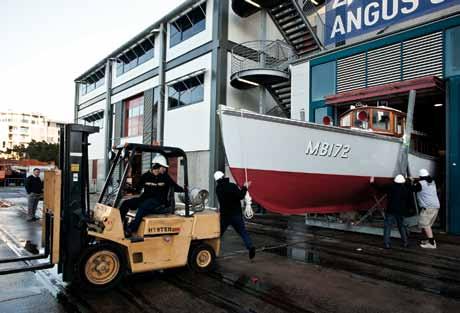
Sydney model Shipbuilders Club inc
The Australian National Maritime Museum is providing the bi-monthly meeting venue for what is believed to be Sydney’s first club for period ship model builders, incorporated recently by a small group of ship modellers who pooled their enthusiasm and ideas over the past 12 months to found the Sydney Model Shipbuilders Club Inc.
The club has been planned to cater for anyone from a beginner thinking of starting model shipbuilding, right up to the most experienced modeller. It will provide a forum for the exchange of ideas and techniques, with the aim of fostering and maintaining an interest in building period model ships and boats, promoting the art and craft of model ship building to the wider community and encouraging interest in Australian maritime history.

It is envisaged that members will display models and modelling techniques to the public at certain venues around Sydney, in the future.
Meetings will be held on the fourth Tuesday of each odd-numbered month (January, March, May etc) from 7.00 till 9.00 pm in the conference room off the ground floor foyer of the Wharf 7 Maritime Heritage Centre, where there is free off-street parking. The club thanks the Australian National Maritime Museum for its support in making the venue available.
Meetings will begin with a brief formal session where club matters are discussed, followed by the opportunity for members to give a presentation on some aspect of model shipbuilding during the second half of the evening, including the
opportunity to bring in works in progress for display, discussion and advice.
To date members have brought in finished works for presentation of ideas, techniques, and constructive criticism, and to demonstrate jigs and other tools used to create models. There have been presentations on the history and construction of ships’ flags and their authenticity, and the construction of hull frames from scratch.
For more information about Sydney model Shipbuilders Club inc please contact its president mike barton on 02 9481 8013 or email modelshipclub@hotmail.com. t he club will soon have its website online with more information and samples of members’ work.
Currents
hotographer r ichard Keyes
p
right:
Sig N al S 96 September t O N O vember 2011 55
Currents
Call for papers for conference 30 may to 1 June 2012
Sydney Aboriginal people plied their harbour in bark canoes they called nawi Early European colonists described the craft as ‘most perfectly adapted’ to their functions. Across Australia there was a huge variation in type, materials and construction technologies, from the bound bark and reed canoes of Tasmania, the flat bark canoes of the MurrayDarling, to the fan-shaped Bardi rafts of north-western Australia and the double outriggers of Torres Strait. There has, however, been little typological study of traditional Indigenous craft across Australia, and no survey of craft in museum and other collections today. There is no national picture of such a significant area of more than 40,000 years of Australia’s maritime history.
In 2012 the Australian National Maritime Museum will host a major two-day national conference on the watercraft of Aboriginal and Torres Strait Islander peoples. The first of its kind, the conference will be an important and vibrant exploration of the wonderful array of traditional craft, their continuity and revival. It seeks to bring together practitioners and theorists from a range of institutions, groups, communities and individuals interested in the history, conservation, construction, interpretation and presentation of Indigenous watercraft. Demonstrations and talks by traditional canoe builders and people engaged in reviving canoe building practices and knowledge will be a highlight.
We are now calling for papers, presentations, displays, demonstrations and performances that explore the history, diversity, significance and interpretation of Indigenous watercraft. Sessions will be held on stories and traditions, diversity and design, imagery, trade and navigation, materials and techniques, interpretation, collaboration and outreach. Papers might address the
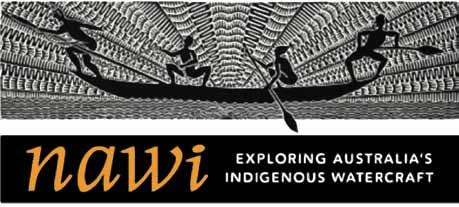

role of watercraft and waterways in historical trade routes, the revival and continuity of traditional canoe-making skills, European and Indigenous views of watercraft, and rivers and oceans as nodes of cultural exchange.
The conference steering committee is made up of museum and community representatives from around Australia including Lindy Allen, Museum Victoria; Dr Keryn Walshe, South Australian Museum; Dr Moya Smith, Western Australian Museum; Tony Brown, Tasmanian Museum & Art Gallery; Dr Stan Florek, Australian Museum; David Kaus, National Museum of Australia; Shane Phillips, Tribal Warrior Association; Dean Kelly, National Parks and Wildlife Service NSW; and David Payne, Dr Stephen Gapps and Daina Fletcher from the Australian National Maritime Museum.
please submit either a written abstract of maximum 300 words, images or a short description of the activity you would like to present. abstracts, proposals or expressions of interest should be submitted by 31 October 2011. t he steering committee will contact you by 30 November to discuss your presentation.
please send proposals and queries to nawi@anmm.gov.au.
For further information contact steering committee chair, senior curator Daina Fletcher on +61(0)2 9298 3777.
to join our mailing list send your email address to nawi@anmm.gov.au or visit the website at www.anmm.gov.au/nawi
Dates: 30 may (evening – welcome function), t hursday 31 may – Friday 1 June 2012.
Conference fee for two days plus welcome function: full rate – $275; early bird (pay by 29 February 2012) and aNmm members 20% discount ($220); concession, presenter, indigenous community members, non-profit organisations 40% discount ($165)
b illy m issi/ a N mm Collection Sig N al S 96 September t O N O vember 2011 56
Outrigger dugout canoe, guugu Yimitthir people, Cooktown QlD. photographer vanessa gillen
P&O Cruises can trace its heritage back 175 years to the formation of the Peninsula Steam Navigation Company which held the British Government contract for a weekly mail service to the Iberian Peninsula. In 1840 the company was renamed the Peninsular and Oriental Steam Navigation Company – creating P&O.
At this time ships were built for the purpose of transporting cargo and passengers only travelled out of necessity. However, thanks to the vision and innovation of Arthur Anderson and Brodie McGhie Willcox the concept of leisure cruising was born.
Today, P&O Cruises strive to innovate and improve much like its forefathers to cater for an ever-growing number of passengers and to provide an unforgettable holiday experience for everyday Aussies.

visit pocruises.com.au





For more
P&O Cruises’
NATIONAL MUSEUM OF AUSTRALIA, CANBERRA TICKETS
FOR PURCHASE IN JUNE.
REGISTER
INTEREST IN ATTENDING, VISIT WWW.AMSA.GOV.AU/21YEARS Sig N al S 96 September t O N O vember 2011 57
information on
history,
FRIDAY, 21 OCTOBER 2011
AVAILABLE
TO
YOUR
Enjoy 365 days of family fun with a Zoo Friends membership.
Join online before 30th November 2011 and get 15 months for the price of 12. Go to www.taronga.org.au/zoofriends and quote 3ANMM to recieve 3 months FREE
Get to know the animals.
Zoo Friends annual membership.
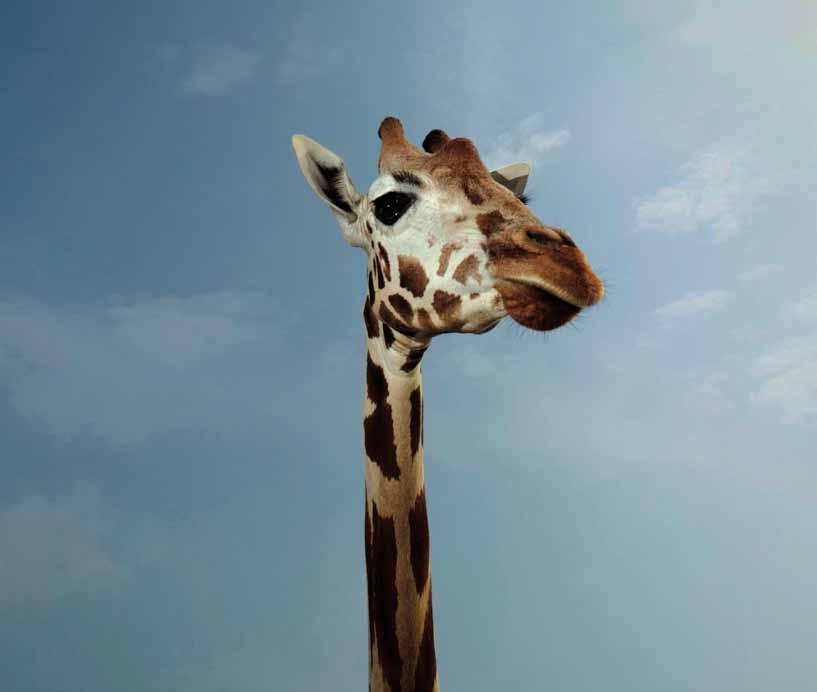
Windows®. Life without Walls™. Toshiba recommends Windows.

Feel the speed and power of Rugby World Cup 2011.
The Portégé R830 is the leader in mobile performance. With its sleek, lightweight design and AirFlow cooling system this 13.3” notebook runs a 2nd generation Intel® Core™ i5 processor. And unlike other portable computers the R830 has a built-in DVD SuperMulti Drive and next gen USB 3.0 ports, so you can take the functionalities of the office with you. That’s Toshiba Thinking. For more details visit www.mytoshiba.com.au
Zoo Friends, Taronga Conservation Society Australia, PO Box 20, Mosman 2088 ABN 41 733 619 876
ABN 19 001 320 421. TM © Rugby World Cup Limited 2008-2011. Sig N al S 96 September t O N O vember 2011 58
Endeavour voyage partner to track turtles
An endangered Loggerhead Turtle rehabilitated by Taronga Wildlife Hospital may help unlock the secret migration habits of marine turtles, reports Endeavour voyage partner Taronga Conservation Society Australia. The young turtle arrived at Taronga Zoo in March 2010 after washing up on Corrimal Beach, NSW, in need of veterinary care. Now, subject to medical clearance, the animal will be released with a satellite tracker attached to its shell, providing researchers with valuable data about turtle migration habits.
Taronga Wildlife Hospital Manager, Libby Hall, said: ‘Very little is known about the journey of Loggerhead Turtles once they leave Australian shores. They hatch on beaches in Queensland and are at sea for up to 30 years, before returning to the same beach to lay their eggs. Where they go and what they do in those years is pretty much a mystery.’
Until recently, it was thought that turtles were swept along with the ocean currents, but research in the North Pacific has revealed that turtles are not just passive passengers but some of nature’s most accomplished navigators. Loggerhead Turtles (Caretta caretta)
occur around coral reefs, bays and estuaries in tropical and warm temperate waters off the coast of Queensland, Northern Territory, Western Australia and New South Wales – the waters that the Endeavour replica is traversing on its circumnavigation. They can grow to well over 150 kg.
‘The turtle was tiny when it arrived. It fitted in the palm of my hand, weighed 62 grams and had a fractured front flipper,’ said Libby. ‘Thanks to a diet of squid and shellfish, it now weighs over five kilograms. If it can swim and use its flipper properly, it will be released off the Queensland coast and its journey will be tracked by satellite. Previously we released turtles and just hoped and prayed they’d do well, but to see where it is going will be fantastic!’
There are seven species of marine turtles and six occur in Australian waters. Marine turtles are listed as a species of conservation concern. Main threats to turtles include entanglement in fishing nets and accidental by-catch of long line fishing. Boat strikes are also common. Building a picture of Loggerhead migrations will greatly assist in managing these threats.

Sponsors Museum sponsors Major sponsors austereo blackmores ltd Nine entertainment lloyd’s register asia Olbia pty ltd SbS Project sponsors apN Outdoor Coral Sea Wines Orion expeditions Sydney by Sail Foundation sponsor aNZ Corporate Members Founding patrons alcatel australia aNl limited ansett airfreight bovis lend lease bp australia bruce & Joy reid Foundation Doyle’s Seafood restaurant Howard Smith limited James Hardie industries National australia bank pg, tg & mg Kailis p&O Nedlloyd ltd telstra Wallenius Wilhelmsen logistics Westpac banking Corporation Zim Shipping australasia Partners in the HMB Endeavour circumnavigation 2011–2012 the program provides Corporate members privileged entry to the museum’s unique environment for corporate hospitality. three membership levels each provide a range of benefits and services: Admiral three-year membership $10,000 one-year membership $4,000 Commodore three-year membership $5,000 one-year membership $1,850 Captain three-year membership $1,800 one-year membership $700 Captain Memberships asiaworld Shipping Services pty ltd australia Japan Cable ltd Defence National Storage-rpa google australia HmaS Creswell HmaS Kuttabul HmaS Newcastle HmaS Vampire association maritime Union of australia (NSW branch) maritime Workers Credit Union maruschka loupis & associates penrith returned Services league Sydney ports Corporation regimental trust Fund, victoria barracks royal Caribbean & Celebrity Cruises Svitzer australasia
Significant voyage partners toshiba the History Channel perth 2011 (iSaF) Department of education, employment and Workplace relations Voyage partners Caltex Carnival australia australian maritime Safety authority NSW maritime Defence maritime Services pty ltd taronga Conservation Society australia Media partners the West australian austereo Channel Nine Voyage supporter Seaswift pty ltd Sig N al S 96 September t O N O vember 2011 59
taronga Wildlife Hospital manager libby Hall with the young loggerhead turtle. photograph taronga Zoo
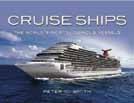
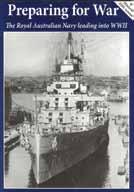

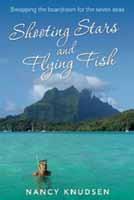
Cruise Ships
the stunning elegance and luxurious interiors of today’s vast fleet of cruise liners remains unrecorded in all but holiday brochures. this book gives a complete overview of the cream of these ships, today’s queens of the sea.
$99.95 members $89.96
Preparing For War
The Royal Australian Navy leading into WWII a fascinating look at life in the raN, including: training, operations, life at sea, specialists (eg divers, medical officers, cooks), signalling, and of course, the vessels and shore establishments. also included are historical pieces on the formation of the raN and its future. this re-issued collector’s item is a must for all naval enthusiasts.
$22.00 members $19.80
Australia’s Fighting Ships
A Century of War and Peace this fantastic new book describes all of australia’s men-o-war from the inception of the Commonwealth Naval Forces in 1901, renamed the royal australian Navy in 1911. Detailed descriptions of the development of warship types and classes are supported by numerous data tables and illustrations. it also examines the future: a well-balanced force of modern guided missile destroyers, frigates, and subs $22.00 members $19.80
Shooting Stars and Flying Fish
When Nancy Knudsen and her architect husband decide to escape their high-pressure corporate lives and follow a dream of sailing around the world together, little do they guess where their journey will lead them. they cross all the great oceans of the world and visit dozens of countries. their adventures are sometimes hilarious, sometimes life-threatening, and lead to the beginning of life-long friendships.
$33.00 members $29.70

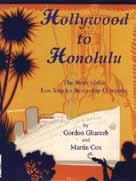
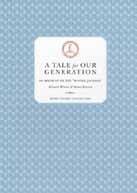
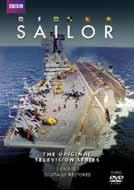
Mini Yacht Bible
Surely one of the most luxurious images in our collective imagination is that of a streamlined vessel crossing the blue line of the sea’s horizon. this book is the ultimate showcase for those who dream of experiencing sea cruising in absolute luxury.
$49.95 members $44.96
Hollywood to Honolulu the story of the ocean liners of the los angeles Steamship Company, laSSCO, that provided not only a regular connection between the mainland and the Hawaiian islands, but were a high-profile means of proclaiming that los angeles was becoming a world-class harbour, financial centre and artistic metropolis.
$69.95 members $62.96
A Tale for our Generation this beautifully presented volume is an account of the gruelling winter journey of lt edward Wilson, Dr Henry bowers and mr Cherry-garrard from robert Falcon Scott’s last expedition to the antarctic 1910–12, as told in our current exhibition. the book includes Wilson and bowers’ own account of their trek to Cape Crozier in the interests of science, its manuscript and some of these delicate illustrations in the collection of West australian Kerry Stokes ac $49.95 members $44.96
DVD – Sailor
Sailor remains one of the best series ever made about the royal Navy, and records the passing of one of britain’s greatest fighting ships, the Ark Royal this DvD also includes the bbC followup programme – Sailor Eight Years On – revealing Ark Royal’s sad fate and going in search of its crew members to discover how their lives have changed. three-DvD set digitally restored. Note: this is a region 2 DvD. You will need to have a DvD player that plays all regions.
$89.95 members $80.96
Sig N al S 96 September t O N O vember 2011 60

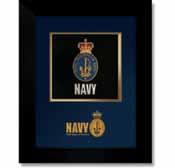

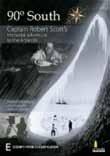
Hundreds of books something for everyone from key rings to ship models and boating clothes friendly service mail order Members discounts!
Open 9.30 am to 5 pm seven days a week phone 02 9298 3698 or fax orders to 02 9298 3675 or email thestore@anmm.gov.au

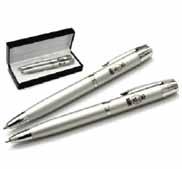

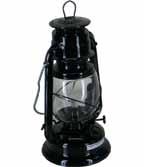
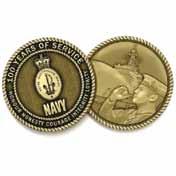
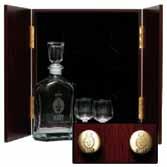


anmm.gov.au
shop online at
Navy pen and pencil set $49.95 members $44.96
Centenary timber case with decanter and glasses $270 members $243 Crafted from 100% silk, sophistication and style for your wardrobe $79.95 members $71.96 Navy Centenary framed bullion badge 250mm x 320mm $150 members $135 Book to accompany the current exhibition $25 members $22.50 DVD 90° South – With Scott to the Antarctic $39.95 members $35.96 Navy Centenary cap $28 members $25.20 men’s Navy polo shirt with raN Centenary logo $59.95 members $53.96 Hurricane lamp 7” $15 members $ 13.50 Navy Centenary medallion in box, 48mm diameter $35 members $31.50 boxed rosewood pen, engraved australian Defence Force crest $45 members $40.50 Captain James Cook figurine 27cm $99.95 members $89.96
Navy
Australian National Maritime Museum
Open daily except Christmas Day
9.30 am to 5 pm (6 pm in January)
Darling Harbour Sydney NSW australia
phone 02 9298 3777
Fax 02 9298 3780
ANMM council
Chairman mr peter Dexter am
Director ms mary-louise Williams
Councillors
mr John Coombes
rear admiral Stephen gilmore am csc ran
mr peter Harvie
ms robyn Holt
Dr Julia Horne
ms ann Sherry ao
mr Shane Simpson
ms eva Skira
mr Neville Stevens ao
Signals
iSSN 1033-4688
editor Jeffrey mellefont 02 9298 3647
assistant editor penny Crino
Staff photographer andrew Frolows
Design and production austen Kaupe printed in australia by bluestar print
Advertising enquiries
Jeffrey mellefont 02 9298 3647
Deadline end of January, april, July, October for issues march, June, September, December
Signals back issues
back issues $4
10 back issues $30
extra copies of current issue $4.95
Call matt lee at the Store 02 9298 3698
material from Signals may be reproduced only with the editor’s permission 02 9298 3647
the australian National maritime museum is a statutory authority of the australian government
Contact us at gpO box 5131 Sydney NSW 2001 australia
Connect with us online
www.anmm.gov.au

































































 marking
CmDr Chris bolton raN (rtd), lt-Commander Harry Howell rNr, anthony White raN (rtd), John murray raN (rtd), CmDr rob everrett raN (rtd). photographer a adam/aNmm
marking
CmDr Chris bolton raN (rtd), lt-Commander Harry Howell rNr, anthony White raN (rtd), John murray raN (rtd), CmDr rob everrett raN (rtd). photographer a adam/aNmm






















































 Ajax
Aoma
Ajax
Aoma




































































